

Fordham’s Orthodox Christian Studies Center Welcomes Ecumenical Patriarch Fordham Reaccredited by Middle States Commission on Higher Education
By JACK MCDONALD ADVERTISING DIRECTOR
Fordham University has been reaccredited by the Middle States Commission on Higher Education (MSCHE). The news was communicated to the university body on Sept. 16 in an email by Greer JasonDiBartolo, Ph.D., associate dean of Strategic Initiatives and executive director of Operations, and Melissa Labonte, Ph.D., associate professor of political science. The reaccreditation is effective through 2033.
MSCHE is an organization recognized by the United States Department of Education that promotes peer evaluation in higher education. It was first established in 1919 and is headquartered in Wilmington, Delaware.
“The Middle States Commission on Higher Education (MSCHE) is a regional accrediting body that reviews colleges and universities to make sure
SEE MSCHE, PAGE 4
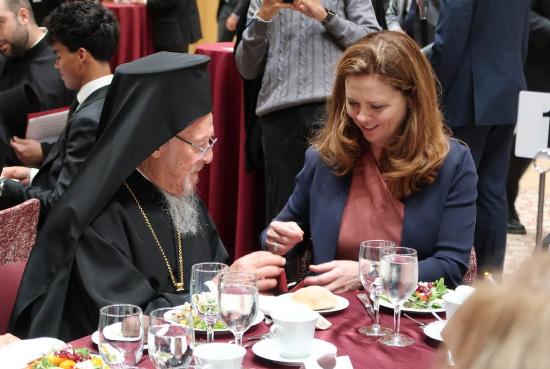
Fordham Welcomes New Senior Director of the Center for Educational Innovation
By JORDAN DONEGAN STAFF WRITER
Fordham has named Margaret “Meg” Konkel, Ph.D., as the inaugural senior director for a learning center that is in development at Fordham. In her new position, she will aid faculty in navigating challenges that generative artificial intelligence (AI) presents to the classroom setting while strengthening their teaching practices.
By SIDNEY BLASCO CONTRIBUTING WRITER
Bartholomew I, Archbishop of Constantinople-New Rome and Ecumenical Patriarch, spiritual leader of 300 million Orthodox Christians worldwide, visited Fordham University on Sept. 23. He was honored with the Presidential Medal and was welcomed with a concert by the renowned Capella Romana in the University Church. This marked the Patriarch’s
second visit to Fordham, making it the only higher education institution he has visited twice. This return acknowledges Fordham’s effort in advancing Orthodox Christian studies on campus.
“Bringing him here is really a kind of validation,” said George Demacopoulos, co-director of the Orthodox Christian Studies Center. “That we are doing work that is valued by the institutional church even
Students Gather for Annual Keating Steps Showcase
By ANDREW MASSIE FEATURES EDITOR
Speakers amplify the notes from an a cappella chorus as students press closer to the front, and for a couple of hours on a Friday night, the university’s most iconic
building becomes a stage.
This is Keating Steps.
Organized by the United Student Government’s (USG) Student Experience Committee, Keating Steps is an annual showcase that pulled a dozen acts and a cross-section of Fordham
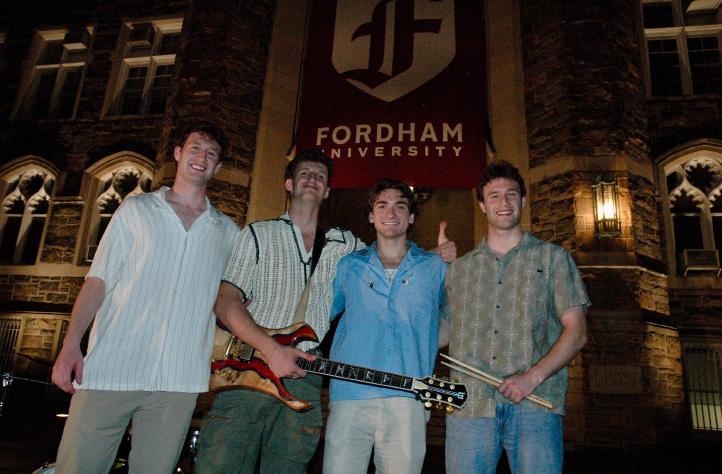
University to the steps at 5:30 p.m. on Sept. 26.
Performers ranged from dance crews to vocal groups; the bill included Hot Notes, Falak, Apricity, Ramblers, Jetés, Satin Dolls, Flava, Sláinte, Dance Co-Op, B-Sides and Code of Conduct.
Between sets, volunteers raffled off prizes: a Ninja CREAMi, an all-inclusive spa trip, New York Knicks tickets and a cooler of free ice cream kept students on the lawn.
“It was fun,” said Grace Lawlor, FCRH ’27, a member of Dance Co-Op, still catching her breath after a set with friends. “It’s always intimidating performing for a crowd, but it was a good time.”
Lawlor likes the outdoor energy and the backdrop.
SEE STEPS PAGE 6
though we are independent.”
The 6 p.m. evening Church mass featured addresses from University President Tania Tetlow, Demacopoulos and a performance by the Capella Romana. It concluded with public and private receptions in the McShane Campus Center.
The Patriarch was awarded the Presidential Medal Award.
“You model for us faith in action,” Tetlow said. “As a
SEE PATRIARCH, PAGE 5
Konkel, who has an individual interdisciplinary Ph.D. in design education and psychology, arrived on Fordham’s campus six weeks ago to begin her new position as the inaugural senior director of the Center for Educational Innovation, a university-wide initiative that will be centered on faculty development. Konkel spent the last four years at Radford University, where she taught design thinking at the Master of Fine Arts level and worked in faculty development. Now, SEE KONKEL, PAGE 4
Fordham Arts and Sciences Department Restructured
By JACK MCDONALD ADVERTISING DIRECTOR
Fordham University recently restructured its Arts and Sciences department. The changes include a new leadership structure with one dean serving as the head of all arts and sciences at Fordham. The restructuring is part of a project to enhance leadership structure, according to the University website.
The restructure “will foster a vibrant intellectual environment and improve efficiency, coordination, and transparency, as well as ensure Arts and Sciences has a clear vision and comprehensive strategy,” according to a statement from the Provost’s office on academic initiatives. The Provost’s office approved of this strategic plan in April of 2024 after introducing it in
February of 2023.
Under the new structure, Jessica Lang, Ph.D., was appointed as the inaugural dean of Arts and Sciences. In this position, she serves as the Dean of Fordham College at Lincoln Center (FCLC), Fordham College at Rose Hill (FCRH) and the Graduate School of Arts and Sciences (GSAS). Lang previously served as Dean of the Weismann School of Arts & Sciences at Baruch College, where she focused on strengthening program collaborations between Baruch’s three schools, alongside the Zicklin School of Business and the Marxe School of Public and International Affairs. Four administrators serve under Lang: Rachel Annunziato, vice dean for Undergraduate
SEE ARTS, PAGE 5
President Tetlow gives the Presidential Medal to the Patriarch at a private reception hosted in McShane.
SIDNEY BLASCO FOR THE FORDHAM RAM
Student band, Code of Conduct, stands in front of Keating after performing.
MARTINEZ REYES FOR THE FORDHAM RAM
Rose Hill Sept. 27
4:36 p.m.
On Saturday, a student reported receiving an email about a remote job opportunity. The email said “Fordham University is offering a flexible, remote part- time employment opportunity designed to accommodate both academic and personal schedules. This role requires only 1–2 hours per day, 3 days a week, and no prior experience is necessary making it ideal for those seeking supplemental income and valuable administrative experience.” The supervisor contacted Fordham Information Technology. The email was found to be a phishing email. Fordham Information Technology issued an alert to the community.
Walsh Family Library Sept. 23
4:40 p.m.
On Tuesday, there was a stuck occupied elevator in the William D. Walsh Family Library. The supervisor responded and notified the elevator company. A technician responded and freed the students.
McShane Campus Center Sept. 23
11:53 p.m.
On Tuesday, there was a stuck elevator inside the McShane Campus Center. The supervisor responded. The elevator company could not provide an estimated time for arrival. The supervisor contacted the FDNY to respond and freed the students.
Rose Hill Sept. 6
9:51 a.m.
On Friday, a student reported that they responded to a GroupMe message for concert tickets. The offender requested a photo and copy of the reporter’s Fordham identification. The reporter declined to provide the information and suspected the ticket offer was fraudulent and reported the incident to Public Safety.
Follow The Fordham Ram on Instagram, Facebook and X @TheFordhamRam
This Week at Fordham PUBLIC SAFETY BRIEFS
Wednesday Oct. 1 Marketing Career Fair Great Hall
12 p.m.
The Career Center is hosting their 2025 Marketing Career Fair held in partnership with the Marketing Department and will allow students to discover job and internship opportunities in McShane.
The Intersection of Politics, Veterans and Disabilities
By EMMA LEONARDI ASST. NEWS EDITOR
While many students were enjoying their summer breaks in the month of July, Megan Ruzicka, FCRH ’27 was working alongside Jacob Smith, an assistant professor of political science at Fordham University, to conduct a study on the intersectionality between politics, veterans and physical disabilities.
On Sept. 24, Ruzicka and Smith presented their research to a small audience in Keating Hall Room 124.
The study was inspired by Republican senate candidate Samuel Brown, who campaigned for the 2024 election cycle. Brown is a veteran who served in Afghanistan and sustained life-threatening injuries after an explosion burned him alive. The incident also caused him to develop a physical disability.
To begin their presentation, Ruzicka and Smith referenced not only Brown but also existing literature on their topic. For voter perception, they found that “Threatening faces, despite no negative context, were found to be successful in predicting election losers,” as per research done by Kyle Mattes and others in 2010.
In terms of social constructs, studies by Meredith Kleykamp, Crosby Hipes and Alair MacLean in 2018 show that voters tend to publicly show support for veterans, but not vote the same way.
Ruzicka and Smith used these existing studies and Brown’s case to form their own hypotheses: “Electoral support for veterans seeking office will vary based upon whether messages about them place more emphasis on their veteran status or disability status and related attractiveness.”
To go alongside this theory, they also mentioned that voters will be less likely to support candidates if they are given images of veterans with physical disabilities, and that they will support these candidates more if given stories of their bravery and sacrifice.
Their second hypothesis theorized that, “Voters will rate candidates differently based upon whether messages place moreiuooyoy emphasis on their veteran status or disability status and related physical attractiveness.” Additional information suggests that voters who see images of a veteran with a physical disability will rate them less highly across a series of proposed traits, and when they are presented with information about the veteran’s bravery and sacrifice, voters will rate them more highly alongside the same traits.
For their third and final hypothesis, Ruzicka and Smith proposed that, “Even when they support the election of the veterans into office, conservative participants will be less likely to support issues surrounding veterans when asked indirectly compared
to liberal participants.”
Ruzicka and Smith conducted their study on July 21, 2025. There were around 2,320 respondents for each hypothesis.
They used four conditions to analyze hypotheses one and two, and two questions to analyze hypothesis three. The four conditions included variations in the description of the candidates, with two of the conditions also having pictures of the candidates. The questions were the same.
Ruzicka and Smith reported significant results for their second and third hypotheses, but not their first. Their results showed that participants consistently rated Brown lower in terms of the traits “attractive” and “strong,” and that conservatives were less likely than liberals to support candidates who support increases in funding for veteran healthcare.
During the question portion for their presentation, Associate Professor of Christian Spirituality and Ignatian Studies, as well as acting Dean of the Graduate School of Religion and Religious Education, Francis X. McAloon, S.J., asked Ruzicka and Smith about the correlation between appearance and presumption of strength and if there was a distinction among different kinds of disabilities.
Smith provided historical context for his answer. “It definitely potentially could. At
least, very historically, there likely would have been other cases … of discrimination,” said Smith. “Bob Dole, when he was in the Senate and running for president, who had damaged one of his arms, tried to hide that in campaigns.” Regarding the differences between disabilities, Smith noted that this could be a potential next step in research.
“Despite the injury to his arm, [Dole] put a pen in [his arm] to make it appear as if it was normal. So I think it also comes down to our voters being able to easily identify the disability to discriminate against it,” Ruzicka continued.
Ida Bastiaens, a professor and chair of the political science department at Fordham, asked if Ruzicka and Smith had taken political parties into consideration during their study, considering the polarization occurring in the United States. Smith noted that they had included political parties in their research to make it as realistic as possible, but they didn’t include them in their analysis.
Smith shared that there are ways to generalize their research to the population outside of political party affiliation, possibly in a follow-up study. “I do think, though, a good analysis we should do is to the independents here,” Smith said.
Specific numbers and visual representations of Ruzicka and Smith’s data are represented in their presentation.
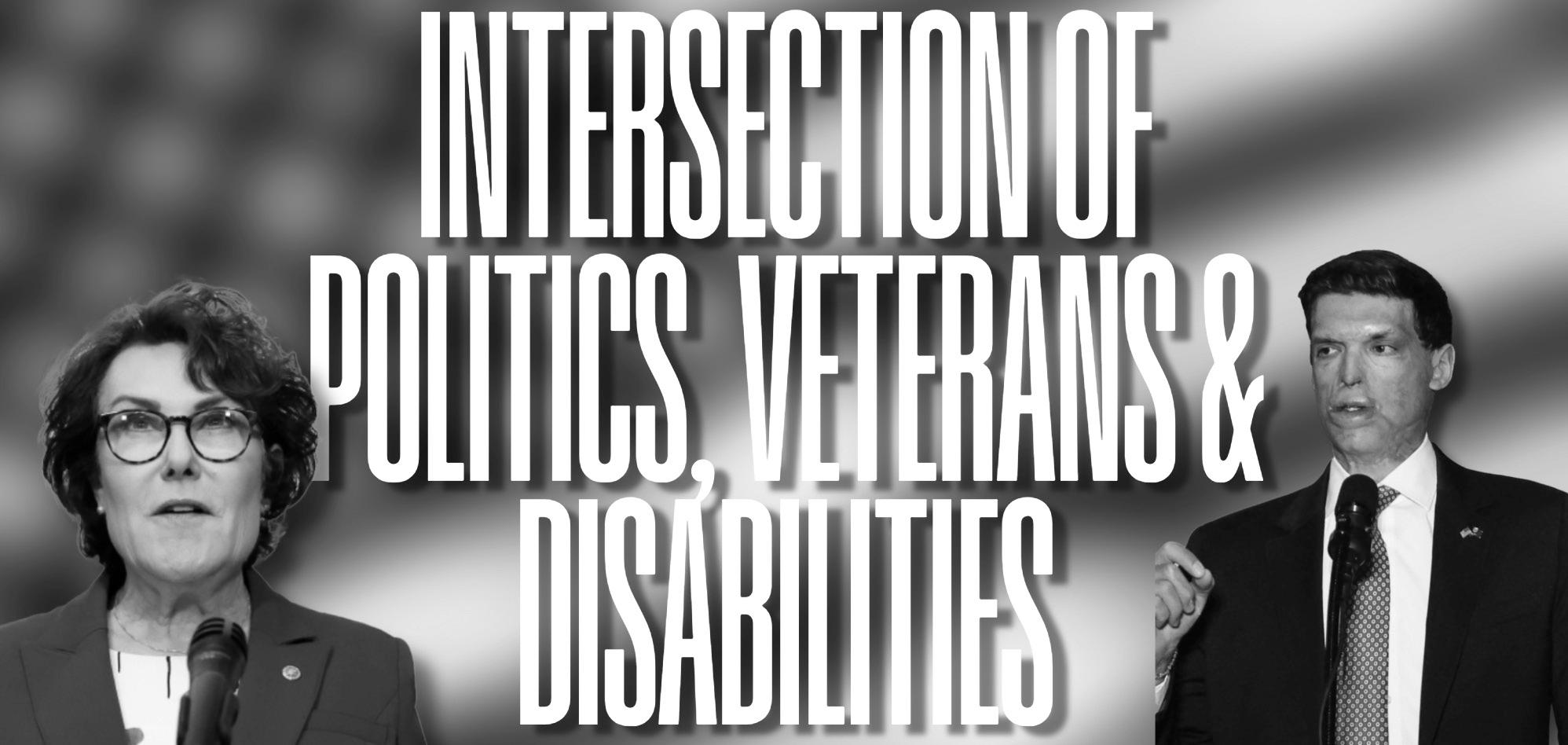
Wednesday Oct. 1
Friday Oct. 3 Guggenheim
Thursday – Sunday Oct. 2 - 5 She Loves Me Collins Auditorium 8 p.m.
Join the Mimes and Mummers for their performance of “She Loves Me,” directed by Stacy Hawking. Tickets are $10 for patrons and $5 for students. Thursday night is free for students.
A study from Megan Ruzicka and Jacob Smith shows some statistically significant data when it comes
MEGHAN CATTANI/THE FORDHAM RAM
Gonzalo Duran Discusses Founding Devil Dog U.S.A.
By SIENNA REINDERS NEWS EDITOR
Gonzalo Duran’s, PCS ’14, life has been shaped primarily by two experiences: being the son of an immigrant and being a United States Marine veteran. Both of these identities have significantly impacted his perspectives and values and have influenced the trajectory of his life, leading him to create a non-profit, advocate for veterans’ rights and ultimately run for office. Now, Duran is continuing his work by running for New York City Public Advocate as the Republican candidate.
Duran grew up in Belmont, where he was raised by a single mother, who was an undocumented immigrant from El Salvador — Duran’s mother has since gained her United States citizenship. He said she worked multiple jobs to care for him and his younger sister. He also said that his socioeconomic status pushed him to work hard and be an overachiever.
“Growing up in that type of environment, it was hard, now that I look back at it, but it gave me a desire to do more,” Duran said.
As a kid, he was always interested in animal science. In high school, Duran took zoology classes at the Bronx
Zoo, volunteered at his school’s animal lab and volunteered at the New York City American Society for the Prevention of Cruelty to Animals. However, while he wanted to be a veterinarian to pursue his love of animals, Duran knew it would be difficult due to his socioeconomic status.
After Duran spoke with a military recruiter, he decided to join the Marines as soon as he turned 18 in June 2003. He served for eight years, during which he received an on-base education and then ultimately earned his associate’s degree from Central Texas College.
Duran completed his boot camp in South Carolina and did his training school in North Carolina before being stationed in Hawaii. He also did a tour in Iraq. He said that his time in the military opened his worldview and made him realize how much there was outside of New York City.
“I didn’t know the ocean was blue until I went [to Hawaii],” Duran said. “I had never left New York City until … the military. Taking the bus past Charlotte … seeing all the lands, the mountains, all that stuff and realizing that the city has you in such a small bubble, and when you leave it is so different.”
When he returned home in 2011, Duran had faced
homelessness for about four months due to his inability to use his Government Issue (G.I.) Bill benefits as proof of income. He eventually moved back in with his mother in Belmont and got a job at the New York State Department of Labor and a paid internship at the Bronx Veterans Hospital.
While Duran’s return to civilian life was difficult, it gave him an idea to create a non-profit organization that would help veterans reintegrate back into their community. In 2012, he started holding some events such as cigar and charity poker nights to create an environment where people could relax and have fun.
That same year, Duran started attending Fordham’s School of Professional and Continuing Studies in the pre-med program, while continuing to expand his non-profit. In 2013, Duran developed a logo for his organization, named Devil Dog U.S.A., and opened an office in Belmont.
Around that time there was also another Fordham student, who is now deceased, veteran Yegor Zubarev, PCS ’15, that started volunteering at Devil Dog. Duran soon learned that Zubarev was facing the same housing
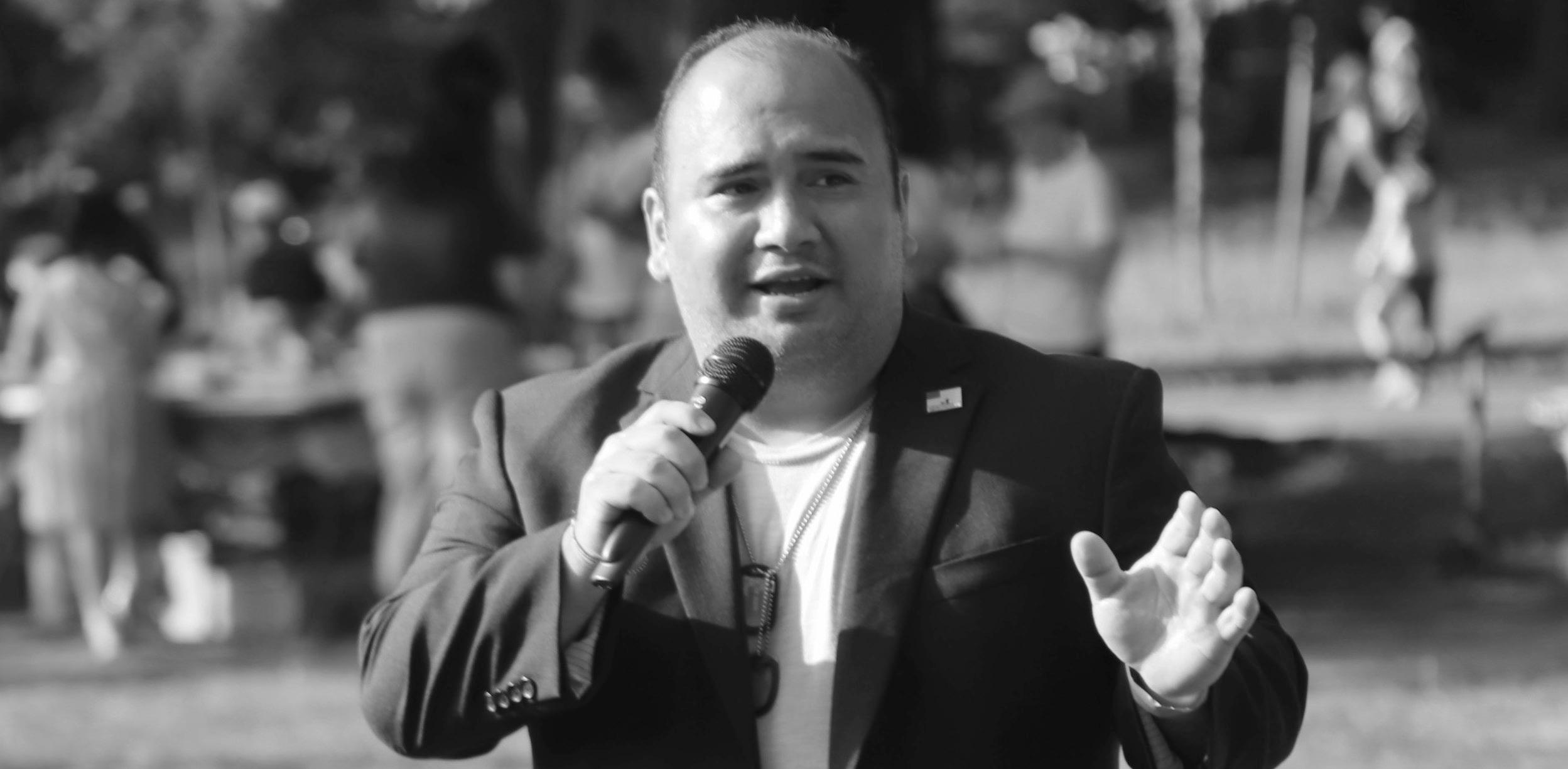
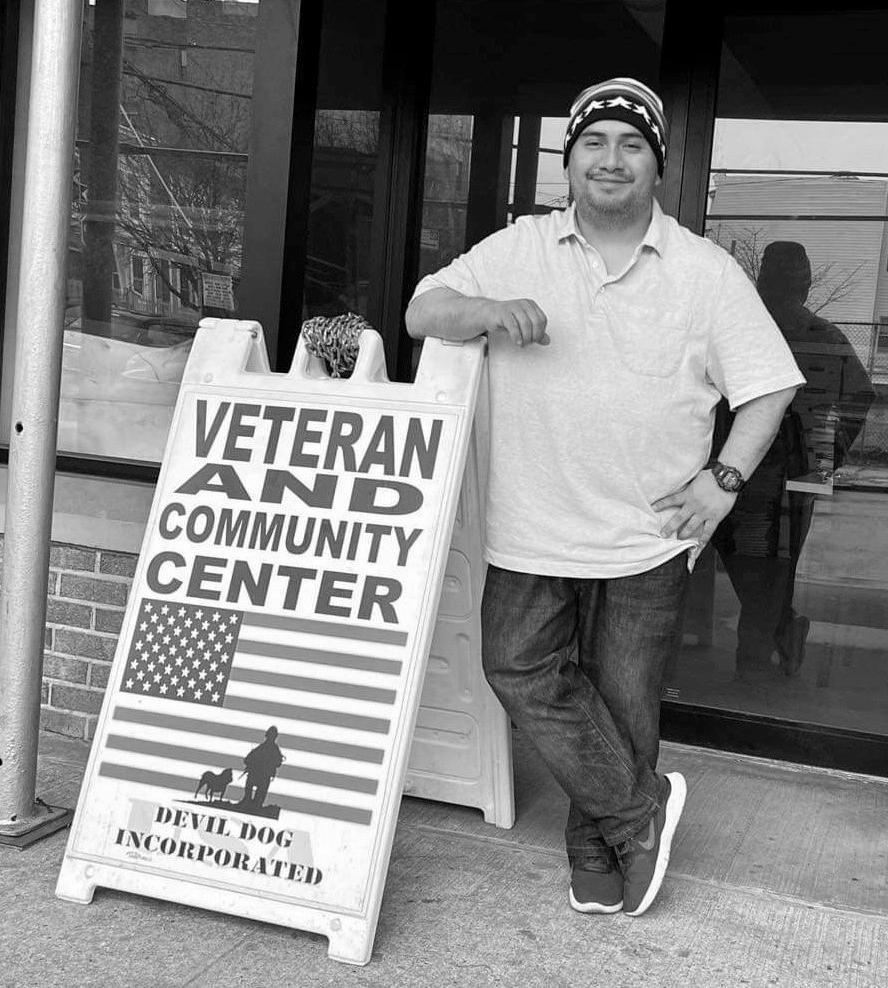
issues that he once had regarding his G.I. Bill not being recognized as income. Hearing Zubarev’s story made him realize that the student veteran housing issue was far bigger than he thought.
“From then on, the whole thing shifted, my concept, my, I guess my mission in life, everything switched right there. And from then on, my goal was to bring attention to that [issue],” Duran said.
Due to Zubarev’s influence, Devil Dog’s main initiative became to help veterans facing homelessness, which Duran specified is a nationwide issue. Duran started writing articles about veteran homelessness in publications including the Bronx Times and speaking to politicians as well as the New York City Department of Veterans’ Services about the current issues, while also advocating for solutions. In 2014, he held a town hall in Fordham’s Keating Hall, which was sponsored by the National Association for Black Veterans, where he presented
solutions for student veteran homelessness.
Finally, in 2017, Duran saw the culmination of his and other organizations’ advocacy efforts when the New York City Commission on Human Rights passed Local Law 119, which reinforced the previous NYC Human Rights Law that states the G.I. Bill is a lawful source of income.
Following his lobbying work, Duran decided to join politics in order to enact legislation himself, rather than simply advocating for laws. In 2023, he ran for District 17 City Council, and in 2024, he ran for District 15 Congressional Representative. While Duran didn’t win either election, he kept running for office. Now, Duran is running for New York City Public Advocate as the Republican nominee. He says he wants to hold a legislative position so that he can bring a voice to the Bronx community.
“My end goal is to make the city better,” Duran said. “And I think I’ve done my part … but I think I can do more.”
USG Meets to Discuss Upcoming October Events
By ANNA GAYTON CONTRIBUTING WRITER
The Fordham College at Rose Hill University United Student Government (USG) met on Thursday, Sept. 25 to discuss upcoming October events on Fordham’s Rose Hill campus.
Executive President Lucas Hjertberg, FCRH ’26, noted that electronic identification cards will be moving to Apple Wallet. Hjertberg also shared Fordham’s Assistant Dean of Student Involvement Catharine McGlade’s advisor report, as she was unable to attend the meeting due to a sprained ankle. He also announced that senior night Oktoberfest will take place Thursday, Oct. 16, from 9 p.m.
to 12 a.m. under the Moglia Field bleachers. Tickets went live Monday, Sept. 29.
Vice President of FCRH Mary Hawthorn, FCRH ’26, discussed an upcoming event with the Dean’s council that will allow FCRH students to engage with their deans and ask questions over Krispy Kreme doughnuts on Thursday, Oct. 2, from 1 p.m. to 2 p.m. in the McShane First Floor Lobby.
Vice President of Diversity Action Coalition Laila Sayegh, FCRH ’27, mentioned two upcoming events, one of which will be Halloween-themed.
Vice Chair of USG’s Budget Committee Siri Bhat, GSB ’27, announced that there have been 30 weekly budget appeals so far this semester. Bhat also noted that Fordham’s Model
United Nations has received a 50% sanction and can only appeal for 25%, meaning the most they could get is 75% of their budget from last year.
Bhat also noted that the Finance Society was awarded $3,000 after Budget Day. This amount brings their total allocated budget for the fall semester to $21,000; they requested $18,000 in weekly appeals for the Wall Street Prep Passport.
The USG Vice President of Operations Tina Pathak, FCRH ’28, and Vice President of Communications Yeonsu Son, FCRH ’27, discussed that after six new club proposals, USG will be more selective with picking new clubs in an effort to focus
on and try to grow Fordham’s current clubs. For those still looking to start a club, there is a new form on USG’s website to begin the club process.
USG’s Vice President of Sustainability Ayden Johnson, FCRH ’27, will be hosting the Fordham Flea Market on Edwards Parade on Oct. 3. Johnson also mentioned a new blueprint for St. Rose’s Garden, and the upcoming Freeman Sustainability Panel.
Vice President of Facilities and Dining Madeleine Ando, FCRH ’27, shared numerous changes, starting with the hope to better unite the student body and USG. Ando, alongside Vice President of Health and Security, Aidan Costella, FCRH ’27, and Sayegh, will work with CPS to
provide more students with long-term support.
Ando also mentioned that the on-campus Starbucks will be granting a 10 cent discount to anyone who brings in a reusable cup. Additionally, a proposal for hammocks on campus did not go through, but Ando states she’d like to have swings on campus, hopefully by the 2026 spring semester. Ando also shared that Ram Hospitality will be partnering with Rockbot, an app that allows students to request songs and downvote others. Frequent users can level up to become a DJ, and prizes may be awarded in the upcoming future.
USG will meet again on Thursday, Oct. 2, for their meeting in Bepler Commons.
Duran stands outside his nonprofit, Devil Dog U.S.A.
GONZALO DURAN FOR THE FORDHAM RAM
Duran is an activist for veteran support, and is very passionate about helping in whatever way he can.
BARRY BROWN FOR THE FORDHAM RAM
Fordham Completes Reaccreditation Process
they provide a high-quality education and operate with integrity,” Jason-DiBartolo said in an email, speaking on behalf of himself and Labonte.
“Accreditation is both a ‘seal of approval’ and an ongoing process of improvement.”
The accreditation signifies that Fordham has met national standards for aspects of higher education, whether it be teaching styles, effective learning or student resources. It is also important for students receiving federal financial aid, since, in order to be eligible for financial aid, students must attend an accredited institution of higher education. Degrees from these institutions also hold more weight in the workforce.
However, the process of receiving reaccreditation by MSCHE was lengthy. “Fordham began its most recent cycle in Fall 2022 by launching a comprehensive self-study,” Jason-DiBartolo said.
Over 150 different students and faculty members took part in work groups, surveys and other assessments, which prompted the organization to examine Fordham’s mission
and whether the university was adequately fulfilling said mission.
“These standards cover elements of higher education from mission and ethics and integrity to the student learning experience to leadership and governance,” Jason-DiBartolo said.
The final self-study report that would eventually earn the university reaccreditation was submitted to MSCHE in early 2025. Jason-DiBartolo said that peer reviewers from universities across the country visited Fordham to convene with administrators, students and faculty about their Fordham experience.
“The Chair of the peer review team was Dr. Gerard Rooney, President of St. John Fisher University,” he said. “Based on the report and evidence submitted by the University, as well as the peer review team’s recommendation, MSCHE granted Fordham reaccreditation in Summer 2025.”
Accreditation is similar to a contract, which lasts for eight years from its issuance. As such, Fordham will need to seek reaccreditation from
MSCHE in 2033. However, Jason-DiBartolo said that despite the university’s current accreditation status, there is still work that needs to be completed during the next eight years. He also said that universities must submit reports and evidence updates to MSCHE during this time.
“These updates demonstrate that Fordham is following through on its commitments, assessing student learning outcomes, and making improvements where needed,” he said.
During the accreditation period, Fordham will continue to collect data and review practices to ensure the effectiveness of institutional actions for students. This research becomes beneficial when the university must once again file for reaccreditation because it provides eight years of qualitative analysis, making it a smoother process for both MSCHE and Fordham. Reaccreditation requires Fordham to take accountability for its actions and make improvements where necessary to ensure the filing is successful.
Jason-DiBartolo said that
reaccreditation is not simply another effort to meet compliance regulations, but a way for Fordham to improve.
“It’s an opportunity for Fordham to pause, reflect, and strengthen the student experience,” he said. He described the process as having brought to light many strengths of Fordham, as well as areas where the university needs improvement.
“The process highlighted many of our strengths, and
it also gave us insights into areas where we can grow, whether that’s sharpening how we measure learning outcomes or strengthening how we align our resources with our mission,” he said. “Reaccreditation confirms that Fordham is delivering on its promise to students, families, and the wider community. It also means that Fordham degrees continue to carry strong value nationally and globally.”
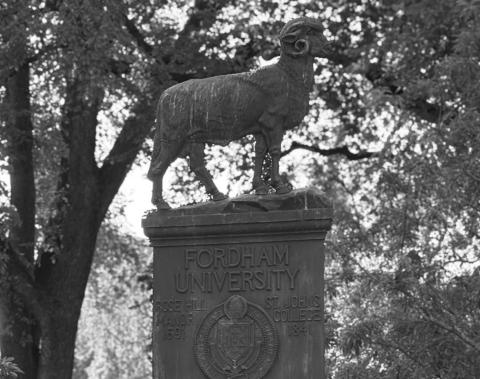
Margaret Konkel Focuses on AI in the Classroom
Konkel has been charged with building a center that she says will centralize faculty support that had previously been scattered across departments.
“I am the director of a place that doesn’t even exist yet, so a lot of what I’ve been doing since I’ve gotten here is talking to people who are doing faculty development already and figuring out how we can work together, or how I can get out of their way,” Konkel said.
According to Fordham University English professor Anne Fernald, Ph.D., Fordham once had a Center for Teaching Excellence that
was initially directed by the late professor Anne Mannion, Ph.D., and was succeeded by Erick Kelemen, Ph.D.. Fernald said that she often worked with the center and offered workshops for faculty development, but that when Kelemen left Fordham, the center was “disbanded.”
Eventually, Fernald served as the special advisor to the Provost for Faculty Development from 2019 to 2023, a role she said, in an email, operated with “no center, no budget, and no staff.” Fernald said she only had $5,000 a year to work with, so she led a smaller initiative to aid faculty transitioning to online and hybrid learning during the
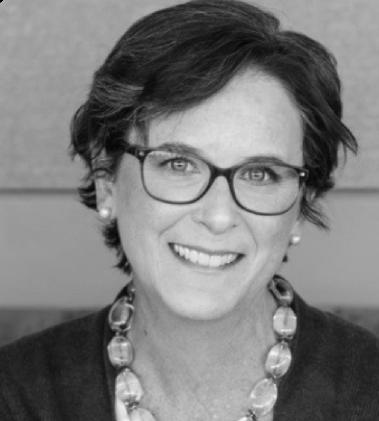
COVID-19 pandemic. However, she stepped away because she felt that she was ultimately not the right fit for the position.
“I wish Meg the best and have already heard good things about the programming she has offered,” Fernald said. “Having places where faculty can gather and learn about teaching with and from each other can only benefit all of Fordham.”
With the new center, Konkel hopes to create a more permanent learning space that will become a hub for faculty development. Her early work at Fordham has consisted of asking faculty about their needs and how she can assist them. Konkel said that the responses she has received from faculty have all regarded one large challenge: the immersion of generative AI and its impact on collegiate academia.
“I’ve been designing the center, and I’ve been really trying to layer my ideas for the visioning of the center that happened a couple of years ago and conversations that are happening today on this campus, particularly the context of generative AI,” Konkel said. “I believe that generative AI is also a faculty identity problem because when a faculty member believes … their core identity is rooted in knowledge creation, AI is a big threat.”
Konkel is not the first faculty member to address generative AI. After Fernald stepped down from her position as the special advisor to the Provost
for Faculty Development, Fordham philosophy professor Judith Jones, Ph.D., stepped in to fill her position in the fall of 2023. Jones said that at the center, she held sessions on generative AI and how to incorporate it into the classroom.
“We had many sessions on AI and creative approaches to either integrating it or at least bringing ourselves around it in at least some informed way, aware that our students will graduate into a world deeply inflected by AI,” Jones said. “I talked to other teachers elsewhere, and they’ve all stopped assigning papers. They’ve stopped assigning laptop exams because of the distrust issue, but we don’t want to distrust our students.”
Jones’ interim conversations laid the groundwork for Konkel, but Konkel’s new job will help institutionalize some of this previous work. Konkel said that the center will not provide answers to the problem of generative AI, because there’s no right or wrong answer to it, but it will try to figure out how to navigate it while supporting faculty.
“We’re not going to solve it. No one’s going to solve it. But we have to actually figure out how to navigate it and we have to support faculty in thinking about how they’re going to navigate it,” Konkel said. “Generative AI in higher education is what we in the design profession call a ‘wicked problem.’ There’s no one answer to it, because the problem is always evolving.”
Konkel said that in the conversations she has had with faculty so far here on campus, she has talked about how to “get creative” in their work and teaching.
“I’ve had conversations with faculty about how to get more creative in what they’re doing, how to do more problem-based learning or active learning … I think faculty on this campus love and want to trust their students, and so how do you balance that with this kind of sense of threat … without taking it out on the students? It’s really hard,” Konkel said.
Many of Konkel’s ideas around conquering the problem of generative AI in the classroom stem from her knowledge of what the “science of learning tells us about how our brains learn things.”
“What we know from brain science is that the people whose neurons are firing the most in the room, in the classroom, are the ones who are doing the learning,” Konkel said. “The trick for faculty is to make the students do more of the work, get things very hands-on, make things very interactive and get the students actually doing the work … Faculty love their fields and sometimes, they love talking about them, but in a traditional lecture model, the faculty’s neurons are the ones that are firing most. So, how do we shift that? I think that’s the big idea that is underneath any work that I’m doing with faculty here.”
FROM MSCHE PAGE 1
FROM KONKEL PAGE 1
Universities must be reaccredited every eight years by MSCHE.
JACK MCDONALD/THE FORDHAM RAM
In her new position, Margaret Konkel focuses on faculty development.
MARTINEZ REYES FOR THE FORDHAM RAM
The Head of the Orthodox Christian Church Visits Fordham
theologian and an inspiring public figure, your message of profound faith cuts through the noise of political rationalization and of nationalism.”
The Patriarch, often known as the “Green Patriarch” for his outspoken environmental advocacy, toured the northeast from Sept. 15 through Sept. 25, meeting with leaders including President Donald Trump, Ukrainian President Volodymyr Zelenskyy and New York City Mayor Eric Adams.
The Patriarch’s visit to Fordham connects with future plans for a new Orthodox Christian Studies Center that is being built in front of Faculty Memorial Hall with plans to complete construction by fall 2028. It will serve as a hub for students in the Orthodox Christian Studies minor and a space for interreligious discourse, being a “beacon of the church in this country,” Tetlow said.
Jayson McArdle, FCRH ’29, who attended the Patriarchal visit, believes the center “promotes an interfaith dialogue … that’s constructive at the end of the day.”
Even though students may not be Christian Orthodox, the Patriarch’s visit signifies
Fordham’s openness toward other faiths. A Catholic student in attendance, Jackson Cutrone, FCRH ’29, called it “a great opportunity to hear one of the most holy figures in our world speak and feel his presence.”
The attendees consisted of students from other New York universities, parents of Fordham students and members of the Focolare movement of the Catholic Church.
At Fordham, the Cappella Romana performed “A Time for Life” — a 50-minute environmental oratorio — in honor of the Patriarch’s ecological work, and received a standing ovation. “Their intention was to highlight the environmental initiatives of our patriarchy,” the Patriarch said. “Which for decades have been most raising global awareness and geological consciousness.”
“I thought it was really special how one of the singers … [came] closer to us,” Antoni Mamouzellos, a SUNY student, said. The Patriarch praised the performance, sharing that it was “deeply moving and has such diverse and meaningful sources.”
The performance was interpreted differently by Cutrone, who said the sweeping vocals reminded him of “the
extended edition of ‘Lord of the Rings: Return of the King.’”
Stratos Mandalakis, FCRH ’84, a sub-deacon under the Patriarch, said that “the Orthodox Church is like the best kept secret in the United States.” He hoped that the event would “bring a little bit of notoriety to [it].”
Following the church ceremony, the guests attended receptions in McShane. There was a public reception, alongside a smaller, high-security private dinner held in the Patriarch’s honor.
This unique event offered a chance to witness a religious ceremony most had never experienced before. McArdle
said students shouldn’t “be afraid to go to events just because it’s a different religion, or we’re not sure if we’ll be accepted.” Noting that it was a welcoming environment.
“It’s kind of like having the pope come to campus,” said Demacopoulos, who wanted students to come away feeling inspired.
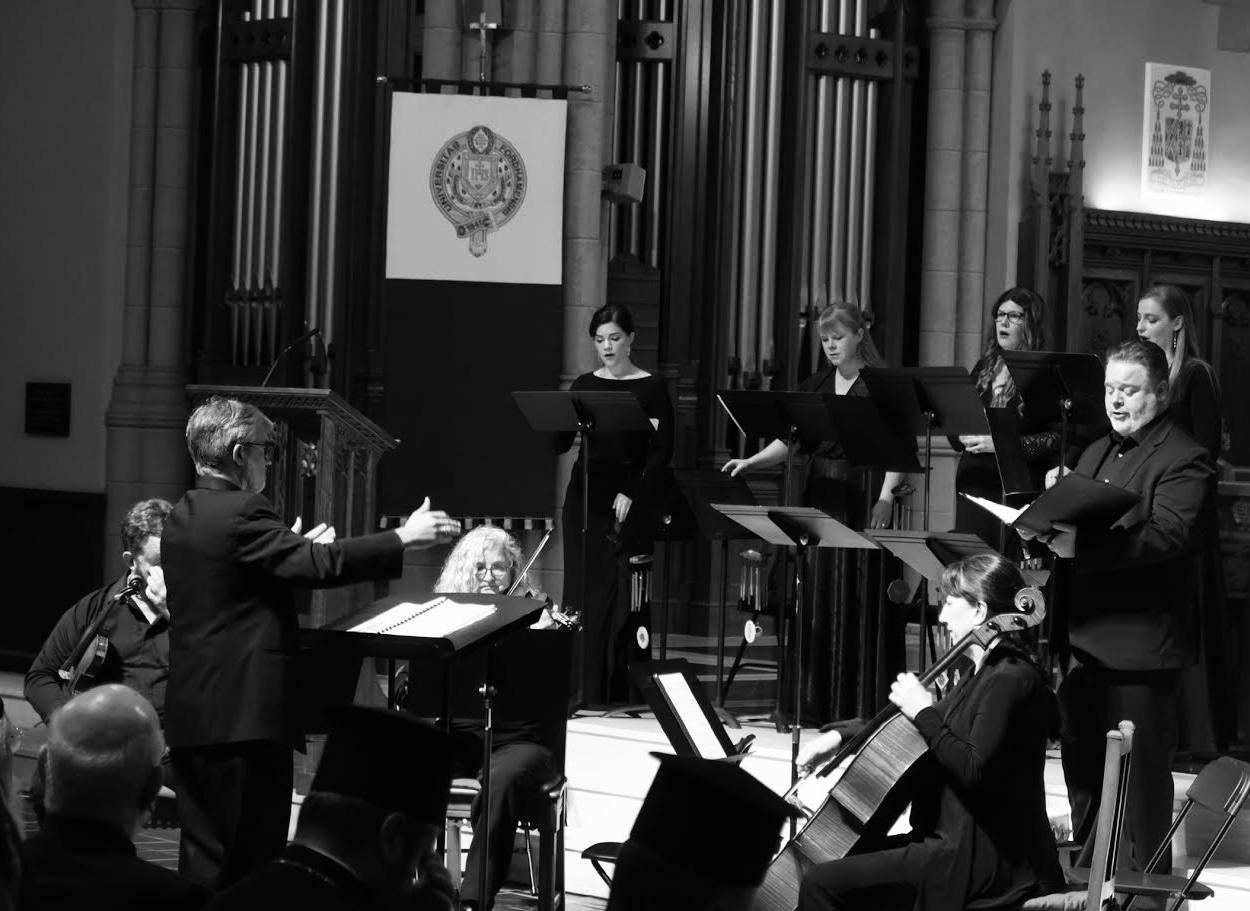
Fordham’s Entire Arts and Sciences Department Now Under One Dean
Education, Ann Gaylin, vice dean for Graduate Education, Robert Hume, Ph.D., vice dean for Faculty Affairs and Terry Yeboah, executive director for Finance and Administration.
Daniel Ott, DMA, senior associate dean for FCLC and Dave Swinarski, Ph.D., senior associate dean for FCRH, also serve under the vice dean for Undergraduate Education. All of these faculty members previously served in other roles at the University.
Ott previously served exclusively as associate professor of music theory and composition, but now serves in his new position in tandem with his previous role.
“I am continuing to teach classes, though on a reduced schedule,” Ott said in an email when asked if he was still serving in his previous role.
Ott noted how his new
role is far different from his previous role. “I am now working in an administrative position as a dean with responsibilities that relate to all of FCLC,” he said. Ott also said that so far, he has done a lot of work behind the scenes in his new job, such as assisting in coordinating new student academic orientation over the summer of 2025.
“[I] have been working closely with Academic Advising on some new initiatives; all the other things that go into making our programs and academic policies here at FCLC run—a huge part of that is working together with my boss, Rachel Annunziato, Vice Dean of Undergraduate Education; and my FCRH counterpart, Dave Swinarski; as well as the new Dean of Arts & Sciences, Jessica Lang,” Ott said.
Swinarski was appointed

to his new position on July 1, 2025. Previously, he served in the math department as a tenured faculty member, department chair and associate chair, among other positions. While he is still a faculty member in the math department, he is not conducting research or teaching this year.
“The associate chair and chair positions were considered part time administrative positions, meaning that I did some teaching and research during those years,” Swinarski said in an email. “The associate dean positions are full time,” he said.
When describing how his old and new positions differ, Swinarski said that while he held leadership positions in math for several years, his new position oversees all of Arts and Sciences, rather than a specific department. He also said that his prior positions focused more on faculty oversight, rather than addressing student issues as he now does.
Swinarski said that another change to the Arts and Sciences department is its location in Keating Hall. He said that he and his colleagues now work closer to Lang and the FCRH Advising Center.
“Last year, Dean Mast and many of her key personnel were in the Keating 201 office suite,” he said. “In August, we moved to Keating 301-302.”
Swinarski also spoke on accomplishments in his new position. “The way to measure any associate dean’s success is by how well they support their dean,” he said. “I am dedicated to supporting Vice Dean Rachel Annunziato–to whom I report–and Dean Jessica Lang–to whom she reports.”
One of the most recent developments in the department has been the tandem advising program, which Swinarski spoke on. “In this plan, each student will have an advising team consisting of an academic advisor plus a faculty member for each of their majors and minors,” Swinarski said. He will be working in close contact with Ott to implement this program across both campuses.
Annunziato was also appointed on July 1, 2025. In her new position, she is responsible for fostering all undergraduate initiatives for the Arts and Sciences and overseeing both dean’s offices at FCLC and FCRH.
“Over the summer months, I worked closely with our new Dean of the Arts & Sciences, Professor Jessica Lang, on restructuring some of our dean’s office roles and advising to provide more robust support,” Annunziato said in an email when asked what she has done so far in her new role.
Annunziato also talked about
changes to the advising program. “Shortly, we will be hiring a pre-professional advisor to offer expertise about not only pre-law but also pre-health and other professions and career paths,” she said. Annunziato also said she strives to make students feel welcome and supported in their academic and professional pursuits.
Of the other faculty members in the Arts and Sciences, Gaylin previously served as the dean of GSAS, a title that has been replaced by her new position. Hume previously served solely as a professor of political science and now holds that position alongside his new title. Yeboah served as the finance director for GSAS before his promotion.
University Provost Dennis Jacobs also shared some comments on the restructuring. “I am delighted that the liberal arts, in all of its richness and complexity, is now under the leadership of a singular Dean of Arts & Sciences, Dr. Jessica Lang,” he said. “As a result of the restructuring, Dean Lang and her leadership team now have the ability to advance our undergraduate and graduate liberal arts programs across both the Rose Hill and Lincoln Center campuses, in a coordinated strategic direction.”
FROM ARTS PAGE 1
FROM ARTS PAGE 1
The Capella Romana choir performed at the church mass that welcomed the Ecumenical Patriarch.
JACK MCDONALD/THE FORDHAM RAM
A spread of science texts at the William D. Walsh Family Library.
JACK MCDONALD/THE FORDHAM RAM
Student Groups Perform on the Steps of Keating Hall
She also knows the tradeoffs. “Sometimes I feel bad for the vocal groups because it’s hard to have good acoustics outside … but we do the best we can,” she said, glancing back at Keating.
For organizers, Keating Steps is also about the logistics. “Location and timing is extremely important,” said Luc Angus, FCRH ’26, the USG vice president of student life, who has been involved with Keating Steps for four years. “I was lucky enough to get blessed with wonderful weather today.”
Last year’s rain forced a
scramble to a backup site, and this year, those behind the scenes kept everything running smoothly. “Backstage has been killing it in the past few years,” Angus said, praising the tech crews that make a stone staircase behave like a stage.
The crowd’s verdict was positive. “Great music, great vibe. Great energy out on Eddies,” said Cooper Barlow, GSB ’27, who came to cheer on friends and stuck around for the mix of student bands. However, he wanted more amplification. “For the level of promotion they did, I think
it’s a very solid turnout,” he said. “But Fordham should have promoted it more.”
First-year students described the night as a low-pressure bridge into campus life. “It’s a chill vibe,” said Mia Paulino, FCRH ’29, who wandered over from the Black Student Alliance cookout when a friend told her to come join. “Sometimes, even as a freshman, you don’t really have that many friends at first. I feel like going to events like this, you could meet new people or you could just be outside in nice weather and just watch a show.”
Isaiah Luna, FCRH ’29,
liked the timing. “The night vibes are more chill than if it was throughout the day,” he said.
A desire for increased awareness was the largest point of feedback. Several students learned about the concert from friends, not feeds.
Angus didn’t dodge the critique. “We promoted it on our social media … but for this year … we’re really looking at expanding our social media presence,” he said. He also wants more consistent residence-hall distribution so fliers reach every dorm.
By the time the last band packed its cables and the crowd drifted home, the light on Keating had cooled back to gray and the echoes hung longer on Eddies.
For the USG committee, the suggestions to start earlier on promotion were clear. For the students who spent the night on the grass, the message was simpler. As Lawlor put it, “It was fun … a good time.”
Fordham’s traditions, like Keating Steps, are not often measured in decibels, but in how many people find their way to the music and, maybe, to each other.
Fordham Solidarity Alliance Holds Discussion on Authoritarianism
By NORA MALONE EDITOR-IN-CHIEF
The Fordham University Solidarity Alliance held an event on Sept. 25 to discuss “Organizing Under Authoritarianism.” The event, sponsored by the American studies department, hosted speakers including former United States Representative Jamaal Bowman, a “Bronx for Zohran” community organizer, a Columbia University student organizer and members of the Immigration Advocacy Coalition at Lincoln Center.
This event was one of a series of teach-ins by the coalition, according to Diane Detournay, Ph.D., senior lecturer at Fordham.
“We’re a group that formed in response to the attacks on the University and the attacks on International Students last year,” she said. “What’s nice about our group is that its faculty, its graduate students, its undergrads, its alumni – we work across various orders in the university.”
Students, alumni and professors attended the event, which was held in Keating Hall 3rd. Over the course of two hours, six different speakers
presented, including Bowman, Professor Christopher Dietrich and the President of the Immigration Advocacy Coalition, Eva Lee, FCLC ’27.
Dietrich kicked off the event with a 10-minute history of Islamophobia in the U.S., where he highlighted what he called the ‘institutionalization’ of American Islamophobia.
Mark Naison, one of the professors who organized the event, brought in speakers involved with Zohran Mamdani’s campaign for New York City Mayor.
“A number of my former students have been very involved in the Zohran campaign, so I’m excited that they’re here to talk a little about their experience,” he said. “I haven’t seen as many of my students and former students involved in a political campaign since Barack Obama’s first run for the presidency in 2008, so that grabbed my attention.”
The event hosted several people involved with both Mamdani’s campaign and New York City Democratic Socialists.
“As a democratic socialist, I wanted to come to support my comrade Cihan Tekay Liu,
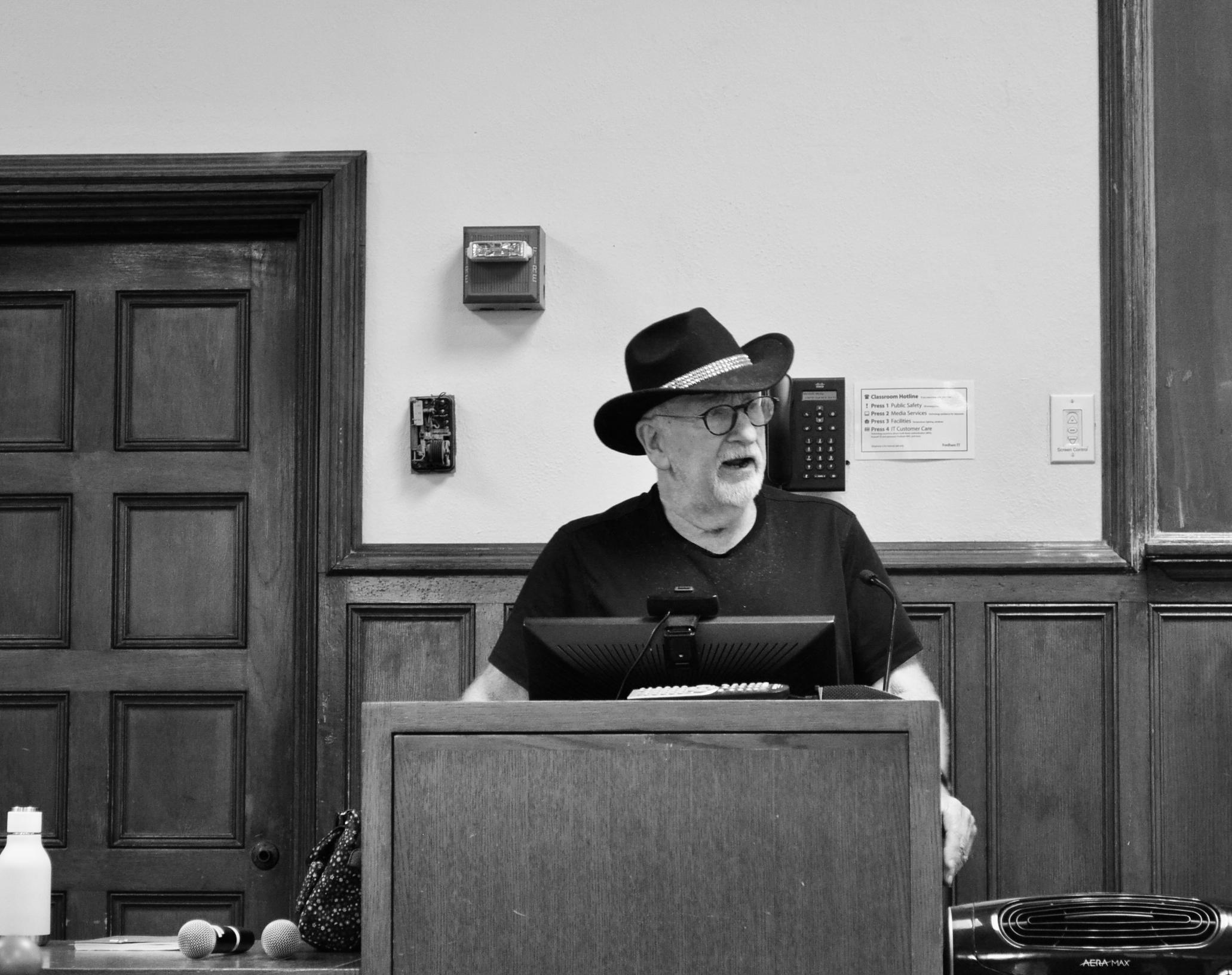
who is an organizer with NYCDSA,” said Matthew Smith, FCRH ’27, an attendee. “And then of course to meet community members who are interested in organizing.”
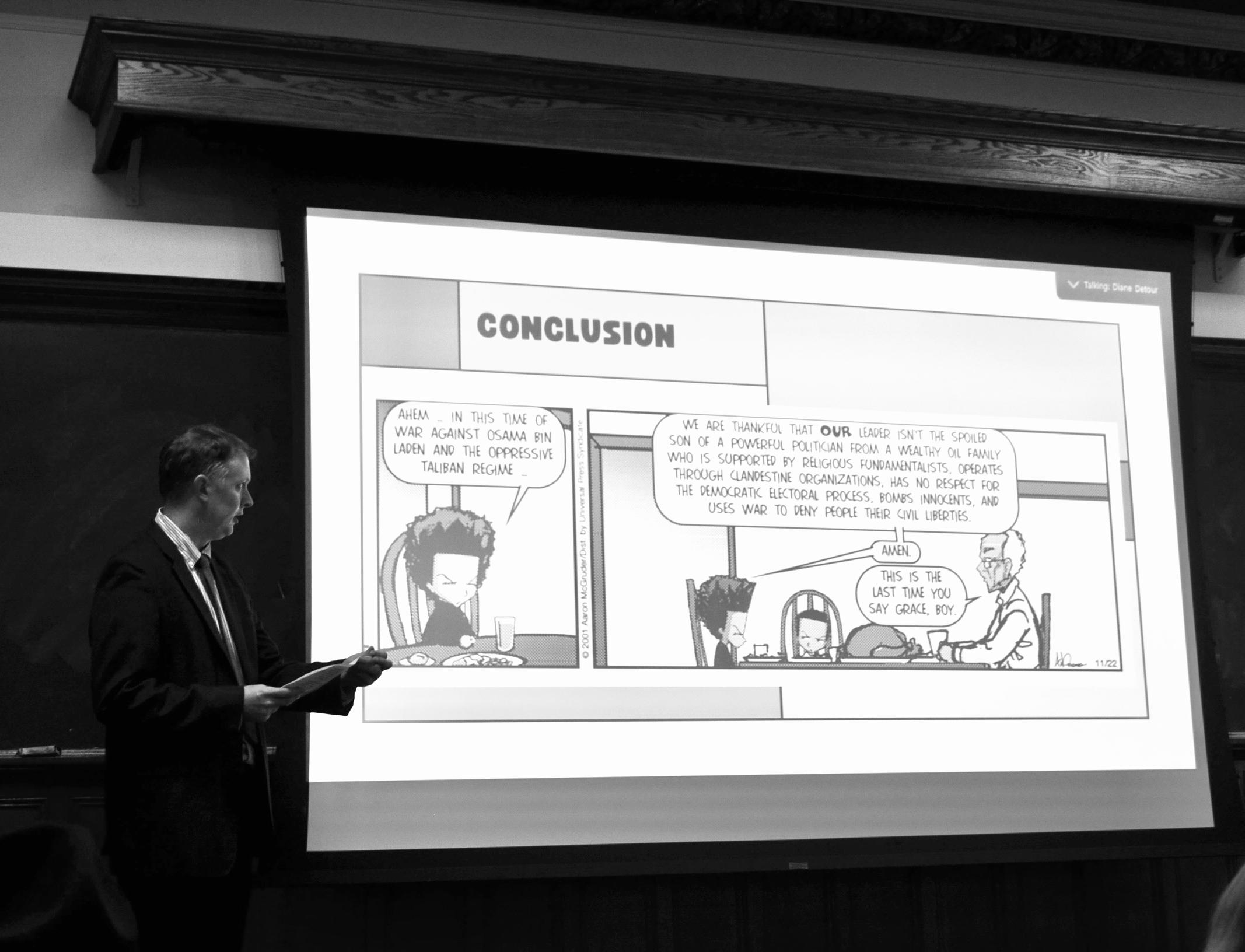
Bowman was supposed to attend in person but was called to D.C.; he joined the event via Zoom.
“The power of your voice cannot be overstated,” he said, referring to the assembled students. “We need you, the world needs you, and we need each other.”
The event gathered around 60 attendees, the majority of whom were students.
Sophie Maier, FCRH ’23, works as a teacher on the Roosevelt Educational Campus and attended the event.
“I came today because Dr. Naison shared the information about the talk with me [because I want to know] what these movements have looked like in the past and what they look like now,” she said.
The goal of the event was to foster a sense of community among students, professors and organizers.
“A lot of professors are excited by this and interested in seeing what this means in this pretty fraught time in American history,” Naison said.
The Immigration Advocacy Coalition wrapped up the
event by sharing the goals of their organization and their recent successes.
“We just wanted to create a safe space for undocumented students and for families,” Lee said. “I am so proud to say we have seen the biggest population of students attending our meetings than ever before, and given this climate, that is so encouraging.”
Currently, the coalition doesn’t have any solid plans for future events, but they intend to continue hosting events like these.
“We hope to continue teach-ins that have to do with the current political conditions and responding to the repression of student activists in particular,” Detournay said. “We are particularly concerned about what’s happening in relation to Palestine justice organizations on campus and the ways it has a really silencing effect … on student activism. So we wanted to connect students to organizers and help them see what is happening in our communities, and there’s a way to get plugged in.”
Professor Christopher Dietrich finishes his presentation at the Solidarity Alliance event.
NORA MALONE/THE FORDHAM RAM
Professor Mark Naison introduces former United States Representative Jamaal Bowman.
NORA MALONE/THE FORDHAM RAM

Serving the Fordham University campus and community since 1918
The Fordham Ram is the university journal of record. The mission of The Fordham Ram is to provide a forum for the free and open exchange of ideas in service to the community and to act as a student advocate. The Fordham Ram is published every Wednesday during the academic year to all campuses.
Website
TheFordhamRam.com
Email Address theram@fordham.edu
Editor-in-Chief
Nora Malone
Managing Editor
Jacob Wolfer
Production Editor
Sophie Maselli
Editorial Director
Jonah Ring
Multimedia Director
Mary Hawthorn
Business Director
Nishanth Aduma
News Editor
Sienna Reinders
Features Editor
Andrew Massie
Assistant News Editors
Emma Leonardi
Lalleyah Camara
Opinion Editor
Stuart Cremer
Assistant Opinion Editors
Abigail Adams
Loresa Zeqiraj
Culture Editors
Mia Tero
Isabella DeRosa
Assistant Culture Editor
Erynn Sweeney
Sports Editor
Grace McCarron
Assistant Sports Editors
Ian Nelson
James Nelson
Copy Chief
Sarah Verrastro
Executive Copy Editors
Indigo Towers
Emily Tonna
Caroline Lehman
Julia Cholerton
Photo Editor
Meghan Cattani
Digital Producers
Haniyyah Usmani
Molly O’Connor
Hannah Sullivan
Advertising Directors
Jack McDonald
Violet Wallace
Faculty Advisor
Beth Knobel
Editorial Policy
The Fordham Ram’s editorial reflects the editorial board’s opinions or views.
Opinion Policy
The opinions expressed in this publication are those of the authors. They do not necessarily reflect the opinions or views of The Fordham Ram.
Submissions Policy
The Fordham Ram reserves the right to reject or edit any submission for any reason, without notice. Submissions become the exclusive property of The Fordham Ram. No part of The Fordham Ram may be reproduced without written consent.
OPINION
Editorial | Free Speech
Big Apple, Not a Jackpot
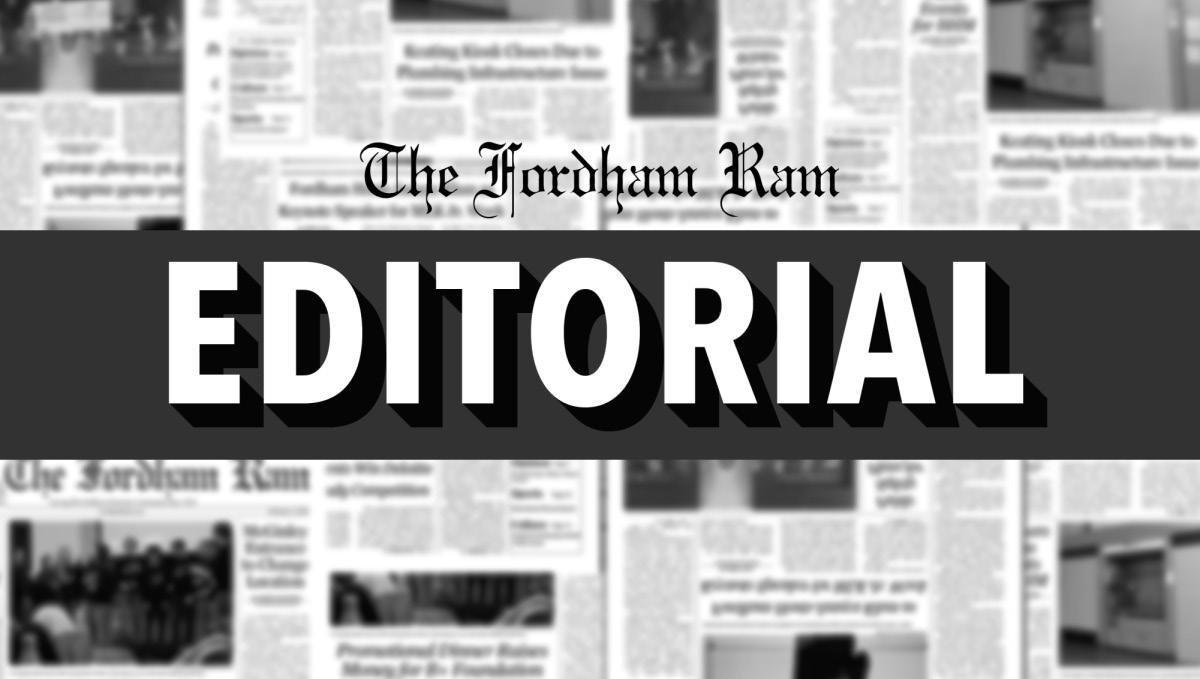
Despite all of modernity’s terrifying features, there is nothing perhaps more troubling than just how willingly contemporary American society has rushed into gambling’s open and conniving arms. Humanity’s oldest pastime (and dangerous addiction) has become, in a word, ubiquitous — just turn on any sports-related television and you will encounter a gambling advertisement every 13 seconds. Just talk to any younger man and there is a 50% chance that he will be sure to ramble on about how this is the week that his parlay finally hit; drive down any major highway and it is almost guaranteed that a squadron of billboards for all the casinos in the area will fly past your window quicker than you can possibly count.
And, rather sadly, this already leviathan-like influence that gambling holds over everyone is only likely to grow in the coming years, especially in New York City. This, of course, is due in large part to the fast-approaching climax of a long and sustained effort to bring casinos to New York State that began all the way back in 2013 when New York voters’ approved a constitutional amendment that authorized the expansion of casino gambling. Put more specifically, New Yorkers are facing a future in which gambling may very well become a physically-real and substantial part of their everyday lives, as state officials on the New York Gaming Facility Location Board and Community Advisory Committees (CAC) are currently deciding how and whether they would like to doll out up to three casino gaming licenses to allow for the construction of three possible New York City casino complexes.
Naturally, seeing as the Fordham University community
is irrevocably a part of NYC’s cultural, socioeconomic and political spheres, The Fordham Ram would be remiss if it did not offer up its own input on what may be one of the largest and most consequential developments in New York City history. Thus, it is the opinion of this editorial board that every member of the Fordham community should protest the approval of these casinos at every level, as these massive gambling complexes pose a significant threat to the cultural and environmental fabrics of NYC.
First looking at the cultural considerations informing The Ram’s rejection of these potential NYC casinos, it should be noted that many of the eight proposals which are still on the table are likely to involve major disruptions to the quality of life in nearby residential areas. Namely, by developing major luxury casinos that will attract massive tourist populations into the area, developers not only run the risk of increasing the present noise, traffic and belligerence levels to an intolerable amount for the surrounding residential areas, but they will also potentially squeeze current residents out of the area by raising nearby rent costs and property taxes. Consider also how the development of these major casino complexes may also necessitate the outright destruction of some of New York’s most treasured cultural sites (e.g., Nassau Coliseum, Ferry Point Park, etc.). Perhaps most notable amongst these potential victims of casino disruption and destruction is the legendary Coney Island itself — the target site of Thor Equities, Saratoga Casino Holdings LLC, Legend and Global Gaming Solution’s “The Coney” casino complex.
The drastic environmental
impact of building these casinos can also not be understated or ignored. In short, they would be a gash across the face of the little bit of environmental stability NYC has maintained, as some of the proposals would not only literally require the destruction of existing green spaces and parks, but the amount of waste produced and resources consumed by these casinos would also be unfathomably large and environmentally draining. Take, for instance, how certain estimates state that these massive casinos may consume upwards of 750,000 gallons of water a day, or how the increased flow of people into the area would astronomically increase traffic levels — the plans for some of these casinos implicitly reveal this expected increase in traffic by calling for anywhere between 2,500 to 6,327 new parking spots — and thus bring about a major increase in the surrounding area’s air pollution levels. Finally, even beyond these dire cultural and environmental consequences, the construction of these casinos will also inflame the severity of already-existent social ills. Namely, they would grant greater access to gambling to a population that has already shown a penchant for immersing themselves in all things gambling. The simple reality is this: people who live by casinos, and thereby have greater access to casinos, are more likely to engage in problem gambling. Put more bluntly, an “increased ease of access” leads to an increased frequency of gambling, which itself in turn leads to an increased amount of money gambled. Considering this then, it seems the construction of casinos is just setting up local populations to fall victim to one of America’s fast-growing, yet most dangerous, vices.
However, credence must be given to the potential benefits of a trifecta of casinos across New York. As with any major development, these casinos would bring with them the possibility of a glut of new jobs and tourism. Take, for instance, the aforementioned proposed casino in Coney Island — that project alone would not just bring in 8 million visitors annually (people who could then theoretically patronize local businesses), but it would also support 15,000 construction jobs and 3,700 permanent unionized jobs. Yet, as New York City Council member Justin Lee Brannan has so aptly pointed out, this economic optimism must be considered in light of the reality that “[c]asinos are designed to keep … your money … inside” their own respective sphere of operations. In other words, while there may be money made and jobs created, it is hard to imagine that there is going to be any sort of meaningful and lasting reinvestment into the community, unless it directly benefits the casinos and the properties/ small businesses that they are sure to snatch up when they, like any for-profit corporation, inevitably look to expand in the future. In light of all that has been just now laid out, it is hard for this editorial board of The Fordham Ram to accept a world in which these casinos will be built. Thus, it calls on everyone to apply as much political pressure as possible to their local CACs, the New York Gaming Facility Location Board and perhaps even their mayoral candidate of choice, in order to make it apparently clear that these casinos are not welcome — the cultural, social and environmental health of New York City may just depend upon it.
OPINION
From the Desk | Emma Leonardi
If It Can’t Be Fixed In Five Minutes
Most people know about the five-minute rule: If someone can’t fix something about their appearance in five minutes, don’t mention it. My life has been majorly altered because of a singular time when someone couldn’t follow this rule.
In sixth grade, I had just moved to Washington, D.C. from Florida, and was starting middle school, without knowing anyone. I had moved before, so having to make new friends was not an unprecedented experience for me. However, I was also going through a major change that we all go through at some point in our lives: puberty.
Though I didn’t know it at the time, I had a genetic predisposition that makes my skin more sensitive to oil production hormones. This is a nice way of saying that I had extremely bad hormonal acne. When I first started to get pimples, I didn’t think anything of them; I actually didn’t notice them at all. About a week into the school year, I was sitting in my assigned seat, which just happened to be next to this guy who decided he had to have a special nickname for me: “Acnefarm.”
Even though at the time I only had a few pimples, he
insisted on calling me by this name for the entire first month of the school year before we finally switched assigned seats. But a month was enough time; my opinion of acne, and of myself, was entirely changed. From that day on, I worked tirelessly to cover up my acne and try to treat it. I also started to pick at my pimples, not knowing that would only make them spread. My skin was so damaged that I wore a full beat of makeup every day (not just school days) for three whole years. I got up insanely early every morning just to make sure I had enough time to accurately cover up. I wouldn’t even allow my family members to see me without makeup.
As my makeup consumption went up, my anxiety and depression did as well. I would get anxious about having pimples, which in turn would make more appear on my face. I developed dermatillomania, or excoriation disorder: a mental health condition where you compulsively pick at your skin, causing injuries, infections and scarring, leading to stress, anxiety and a reduced sense of well-being. I would pick at my skin so much that I was ripping off layers
of skin. I would scratch and scratch until I was bleeding and permanently scarred. I ended up being put on birth control to manage my hormones and my acne subsided enough that when I started high school, I was completely makeup-free. Starting at about the beginning of junior year, however, I had a second wave of puberty. My acne came back in full force, and even worse, it came back as cystic acne.
Cystic acne is a severe type of hormonal acne where large, painful bumps filled with pus or fluid form under your skin. It made me hate my life; every time I tried to do anything, “Acnefarm” would repeat over and over in my head. I became very depressed. My relationships with my friends, and especially with my family, deteriorated. I stopped going to school, I stopped participating in activities, I stopped going outside, I stopped living. I didn’t want to.
It’s scary to me to think of that time, even though I don’t remember most of it (thank you, trauma blocking). It’s also so scary for me to think about how much of an effect something so small can have on a person. Even though having a pimple is not the end
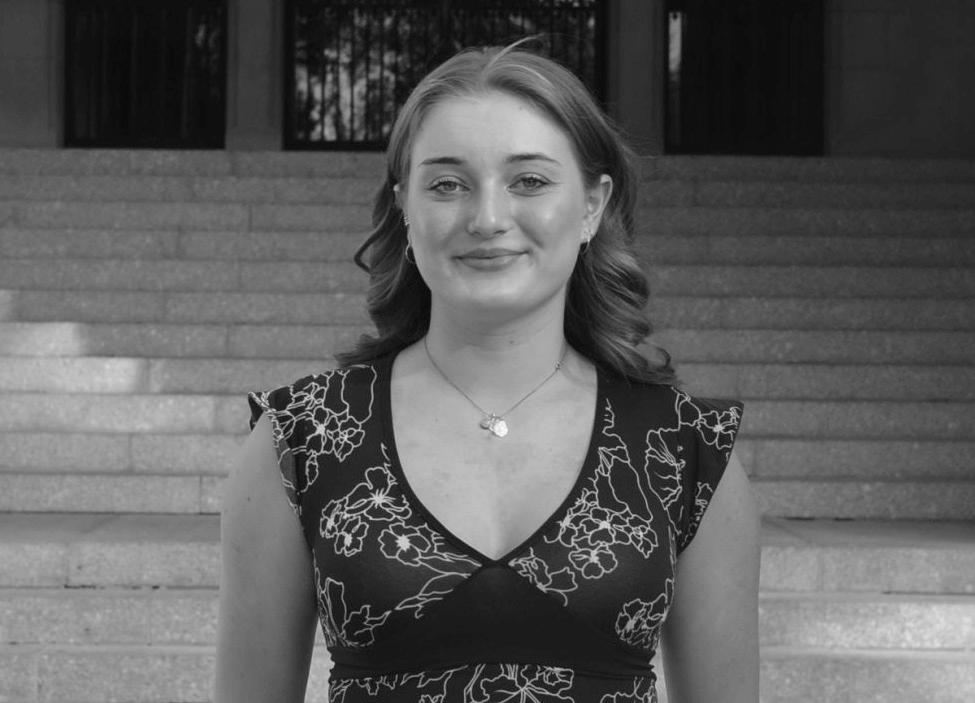
of the world, because of something said to me only a few times, it felt like it.
Thankfully, I ended up being put on not only a stronger, more effective birth control, but I was also able to be treated through anxiety medication and very intensive therapy. I still think about it, and I’m still struggling with dermatillomania, but I can now accept that I have scars and flaws and I am still able to live, but more importantly, I still want to live.
The world around us is a scary place, especially right now. I know that what I went through is nothing compared to what other people go through every day, and there
are so many big changes that need to happen to our world to make it better for everyone. However, we can’t always control everything happening in the world around us.
What we can control is how we treat other people and what words we put into this world. We can refrain from making negative comments about and to each other, especially about things out of our control. Try to give someone a compliment every day; you never know how much they need it. And remember: if they can’t fix it in five minutes, please don’t mention it. The consequences can be deadly.
Transferring Into the Concrete Jungle Where Dreams Are Made
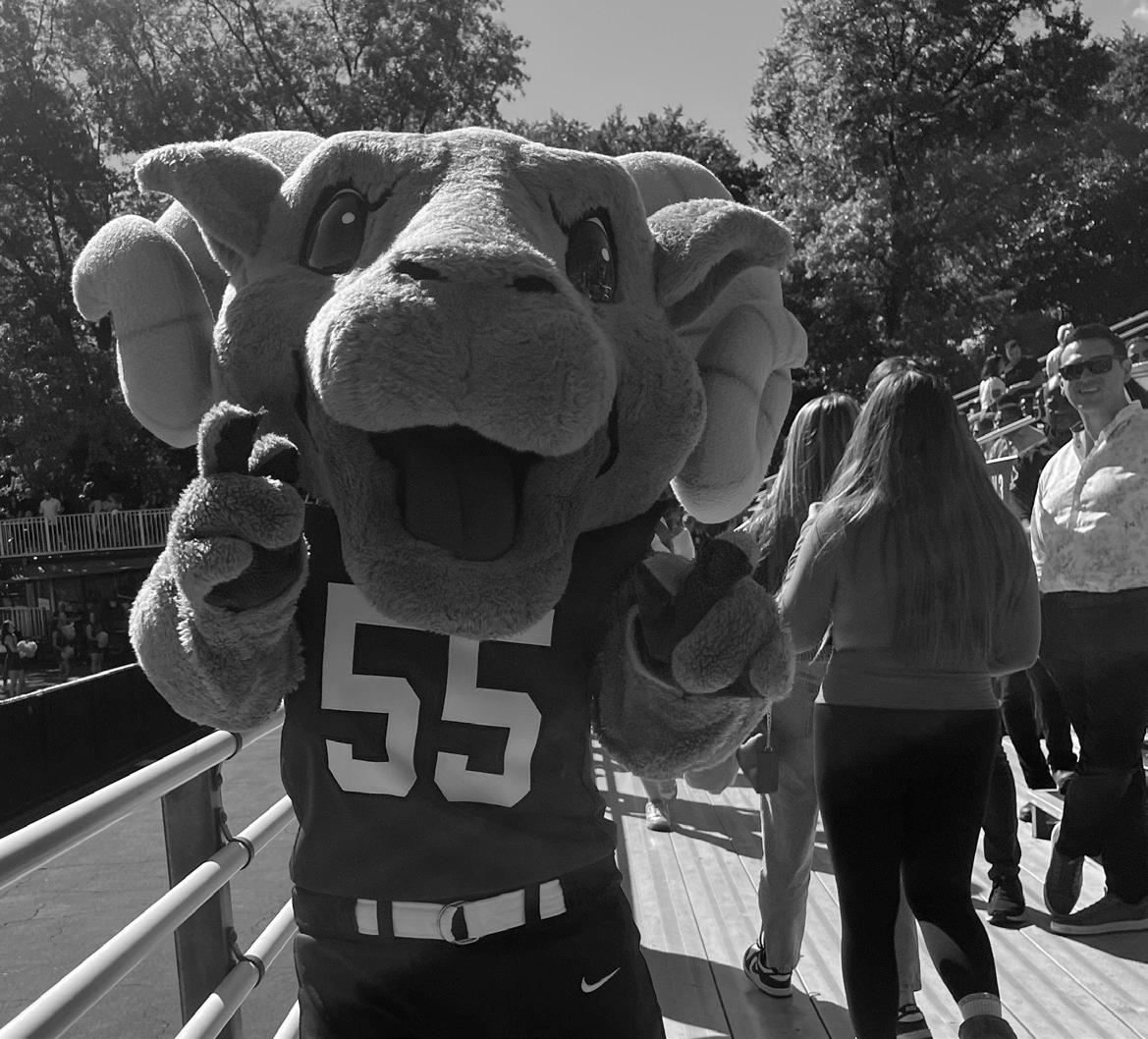
Every year, the transfer department of Fordham University receives a large number of transfer applicants. This year, Fordham admitted its largest transfer class in history, comprising 260 students. As a transfer student, I can provide numerous reasons why students should transfer to Fordham and become a Fordham Ram! Some students cite the sense of community here at Fordham as a reason for considering a transfer. What does Fordham’s sense of community really mean here? Fordham, being an open and diverse institution, welcomes students from around the
world and across the country. Where else would the perfect place to go to school be in the city of the melting pot? The class of 2029 comprises students from over 60 countries and nearly every state in the nation. Many, including myself, are from the tri-state area of the East Coast. For all the students reading this, consider what made you choose Fordham. Was it the location, the majors, the Jesuit values, Fordham’s prestigious reputation or something else?
Fordham University has the ideal balance of city and campus life to begin. When wanting to escape college life and enter Manhattan, the MetroNorth makes it very easy, as it is conveniently right next
to the Rose Hill campus. The close proximity of transportation allows for safety to feel like a top priority at Fordham. However, it’s all about a holistic lifestyle.
New York City, known for its impeccable opportunities — the “concrete jungle where dreams are made of,” — also means an overload of possibilities and people. That is why I appreciate my Fordham community, a place where I can resonate with and rely on others; living in a big city can be isolating at times, so the feeling of social support is essential. Living in New York is like being in a separate country within the United States. There is no other place like this or a mentality like this. Where else can you find endless opportunities, possibilities and the iconic places to live, work, grow and develop?
According to the Office of Admissions Director Jose Oliveres and the Dean of Admissions Patricia Peek, transfer advisors spend a great deal of time making sure our transfer students have the most appropriate academic path, as well as reviewing transfer of credits from previous institutions. The transfer session at Orientation helps create a welcoming environment for transfer students transitioning to Fordham. As a transfer student, I know that going from one school to another can be intimidating and challenging at times.
However, with the fantastic staff at Fordham providing academic, personal and social support, the transition was much easier than I had imagined. Together, they offer a structured environment that helps transfer students adjust to life at Fordham and set them up for future success.
In our conversation, Peek described Fordham’s attraction for transfer students, saying, “Fordham, renowned for its strong sense of community and rigorous academic reputation in the vibrant city of New York, helps students gain hands-on experience through internships, aligning with the Jesuit values of leadership and service.”
The 2025 application cycle received the most significant number of transfer applicants in Fordham’s history. This year, Fordham received the highest number of transfer applications in the University’s history. Peek mentioned how “in recent years, we’ve made strategic enhancements to the application and admission process, which I believe have contributed to our growth by reducing barriers to applying and providing guidance and support during the admission and financial aid processes.”
The transfer enrollment growth “reflects how well the University comes together— from admission and advising to New Student Orientation
and financial aid—to support transfer students and welcome them into our Family from day one,” Peek said. I believe I have made the right decision in transferring to Fordham University, as I have received more than enough support and opportunities to reach my goals post-graduation. The numerous clubs and activities that Fordham offers truly prepare me, highlight my passions and build my skills as a journalism major. Additionally, Fordham opens its doors to a diverse range of students. A Fordham education is studentcentered, showing attentiveness to the development of each individual. Such an education shows the resilience of a collaborative environment of students, professors and staff.
In contrast to academics, The Ramily, a community that supports students from Rose Hill and Lincoln Center, truly lives up to its words. Since 1841, Fordham University has stood for what matters most: making lives better through education and service.
Wherever your destiny is, you can be sure that Fordham’s rich history, diverse educational opportunities and prestigious reputation will help you get to where you want to be.
Fordham offers numerous resource for transfer students. BRIDGETTE LEAHY FOR THE FORDHAM RAM
By BRIDGETTE LEAHY STAFF WRITER
Bridgette Leahy, FCRH ’27 is a journalism major from Basking Ridge, New Jersey.
Stuffy No(se): Don’t Go To Class Sick
By CIERRA ROGERS-NERVO CONTRIBUTING WRITER
The so-called “freshman flu” and its many accomplices affect most new and returning students as illnesses run rampant every fall. Everyone is familiar with strep throat, mononucleosis (mono), the flu, the common cold or some other peculiar illness that comes and goes before the health center can even give you an official diagnosis. As the semester progresses, the “freshman flu” really sets in.
“I have not missed class yet, but there have been many times I should have. I’ve been sick on and off already this year, without a break,” said Allanicole Terletsky, GSB ’28.
While most everyone has fallen victim to a mysterious illness at the beginning of the fall semester — including yours truly, who is currently sniffling while hovering over her keyboard with a cup of warm tea — the question is no longer where we contract this illness, but whether or not it is acceptable to continue to go to class and and expose ourselves to others while one’s symptoms persist.
While it seems inconsiderate and unfair to go to class when knowingly sick, any college student knows that missing even a few days of class without falling behind is unreasonably difficult.
“Realistically, you can’t stay home and rest until you’re
fully better because of how many excused absences you’re allowed to have, and sometimes the health center can’t do anything because it’ll just be a common cold,” said Addison Schwan, FCRH ’28.
According to the National Library of Public Medicine, people carry about 38 trillion bacteria. The exact number of new bacteria each student is exposed to at the beginning of the school year is nearly impossible to calculate. Still, with almost 7,600 undergraduate and graduate students attending class on the Rose Hill campus alone, the sheer volume of microbial exchange is dramatically different compared to a student’s home environment. It is no longer a mystery how or where we get sick. Many first-year students become ill because they come from all over the country and the world, creating a melting pot of new germs. And while students’ immune systems eventually adapt and they get sick less frequently as they make it to the spring, returning students continue to get sick as they are reexposed every year.
“Yesterday, my professor said that he was going to end class here because ‘you’re all sneezing and sniffling and I don’t wanna get sick,’ said Schwan. “I got sick a week and a half in.”
Regardless of whether you
go to grimy house parties or partake in the going-out scene, dining halls, laundry rooms, classes and even your own dormitories are often contaminated by ill students. Avoiding exposure in these public and private spaces is nearly impossible, making it similarly impossible not to get sick.
“I think students should stay home when they are sick so they do not spread it to other students; but it is hard to miss class with always being sick,” said Terletsky.
There are ways to acquire help when sick. The health center is a great resource for getting a diagnosis for your illness and prescription medication. And, according to Fordham University’s attendance policy, “class absences incurred for the following reasons will be considered excused (supporting documentation may be required, depending on the nature of the absence): MedicallyDocumented Illness or Injury.”
While it is technically possible for all sick residents and non-residents to stay home and get the rest they need, you can only miss so many classes before they affect your attendance and individual course grades or before you fall behind on your workload. Even when the health center excuses absences, missed lectures, labs and make-up work can make it difficult for students to catch up, not to mention distracting them

from focusing on rest and recuperation.
“You can be uncomfortable with it, but everyone is in the same situation: not trying to miss too much class,” said Schwan. “If it’s the first day of being sick, and you feel like it’s something serious, then that’s a little inconsiderate [to show up to class], but at the same time, what can you really do?”
Balancing academic responsibilities with one’s personal life is not an easy task. When it comes to mental or physical health, sometimes we forget to find that balance due to the pressure of wanting to keep up with school. Finding the necessary support and caring for yourself is crucial, especially when sick. However, we should not be so quick to judge and criticize a student in class
for sneezing or coughing. Just as we should understand others’ circumstances and even admire those who continue to try to excel academically regardless of their health, it is also essential to be considerate of the nonsick students around you. If you choose to go to class when knowingly sick, practice what we learned during COVID-19: wear a mask, social distance and always remember that sharing notes is fine, sharing germs is not.
Burning Bridges or Building Coalitions? Hochul Endorses Mamdani
By GABRIEL CAPELLAN STAFF WRITER
On Sept. 14, Governor of New York Kathy Hochul endorsed Queens assemblyman Zohran Mamdani to be the mayor of New York City. In my opinion, this is no more than a publicity stunt from the governor. Hochul needs to be re-elected next year if she wants to remain governor, and her approval ratings over the past year haven’t been stellar. With Mamdani leading in the NYC mayoral race polls by 20 points, it makes sense for her to endorse him now, take some heat from the rest of the party and keep her seat next year during the elections.
However, Hochul’s views don’t necessarily line up with Mamdani’s. Hochul is a centrist democrat, whereas Mamdani is a democratic socialist. His proposals include making all NYC buses free, raising the minimum wage to $30 by 2030, opening cityowned grocery stores and providing universal no-cost childcare. Hochul expressed their shared priorities of affordability, safety and standing up to the Trump administration in her endorsement.
But I still have my doubts about this partnership.
These two politicians operate very differently. Hochul has been a staunch supporter of Israel. She called the starvation of children in Gaza “unconscionable,” but has not pledged to do anything about it.
Mamdani, on the other hand, vowed to order the New York Police Department (NYPD) to arrest Benjamin Netanyahu, the Prime Minister of Israel. This issue alone seems like enough to create a large rift between the two of them, but that’s just the tip of the iceberg.
Mamdani has been critical of removing current Mayor Eric Adams from office but Hochul wasn’t as adamant as him. Hochul didn’t want to remove him from office because of the “will of the voters,” which I find rich because there were numerous alarmed civic leaders and elected officials urging Hochul to remove Adams from office.
Mamdani, on the other hand, called to defund the NYPD, until a mass shooting happened in July, where a gunman shot multiple citizens at the New York headquarters of the NFL. When this happened, he went back on his statement, but maintained
his support for police reform. If you ask me, he was not wrong to say what he said in the first place; I don’t think the NYPD should be this militarized or have a $5.6 billion budget, a shift that has been occurring since 9/11.
Going beyond Hochul’s moderate stance, Mamdani criticized Adams’ corruption case, calling it “pay-to-play” politics, something he had to overcome in order to win the democratic primary earlier this year. He beat Cuomo by 12 points and showed the power of a grassroots campaign, leaving a lot of New Yorkers and young voters, like myself, across the country feeling optimistic about the future of the Democratic Party. His victory shifted what the party could look like, but some prominent Democrats from New York, namely Chuck Schumer and Hakeem Jeffries, are still reluctant to endorse him for NYC mayor. Regardless, Hochul’s endorsement didn’t really move Mamdani’s agenda forward much, but it did raise questions from her allies and from the White House. President Donald Trump refers to Mamdani as a “communist,” and he’s a far cry
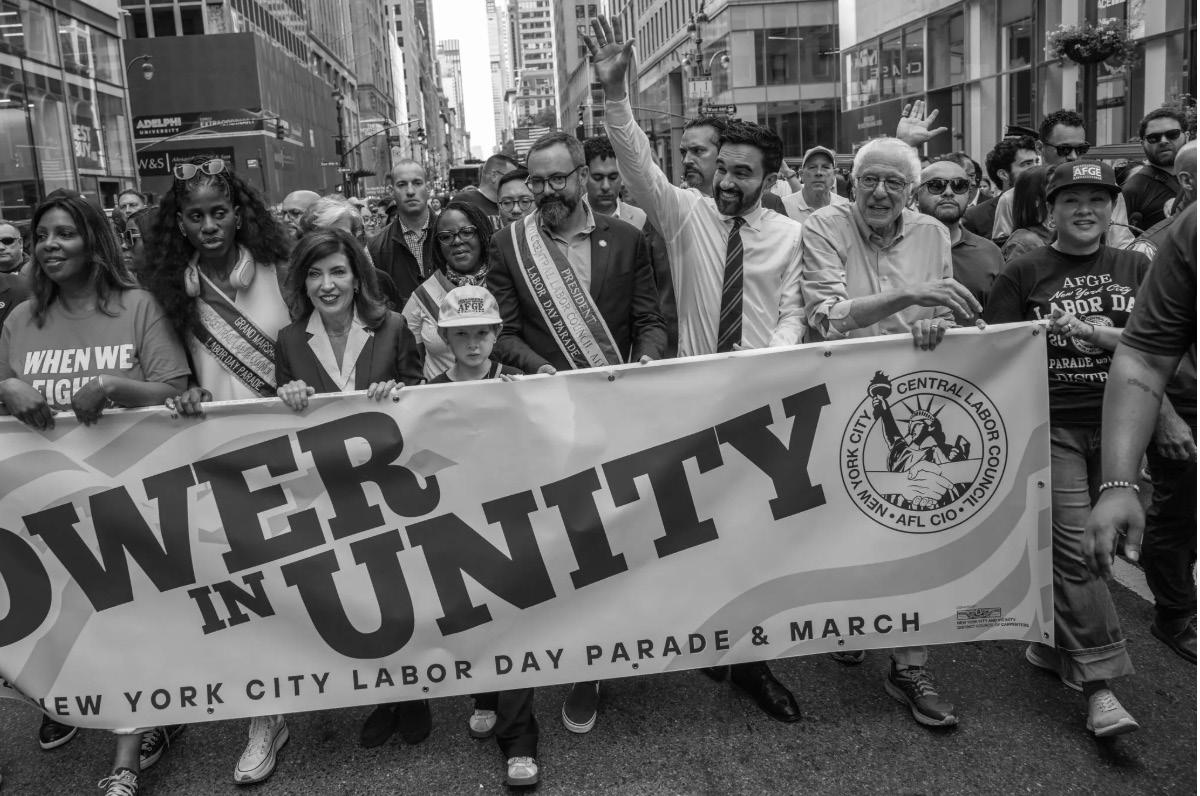
from that; in my opinion, he’s trying to change the city for the better. With the tension between these two officials, the endorsement comes as a shock; they don’t necessarily align with each other, and it puts Hochul at risk with the rest of the party. Her supporters and donors don’t like Mamdani since he wants to raise taxes on the wealthy and make the city affordable for all. The endorsement ties Hochul to Mamdani’s actions, even if she criticizes them later on.
Hochul’s endorsement, from the looks of it, seems to be both a risk and a way to secure her spot as governor again next year in the election. She has to burn some bridges here to remain in her position, and she will have to answer to both moderate democrats and Trump, who already doesn’t like Mamdani.
Centrist Democrats and Democratic Socialists unite in the Hochul endorsement.
COURTESY OF THE NEW YORK TIMES
Cierra Rogers-Nervo, FCRH ’28, is an English major from Santa Barbara, California.
Gabriel Capellan, FCRH ’28, is a journalism major from the Bronx, New York.
COURTESY OF SOUTH FLORIDA ENT ASSOCIATES
Attending class sick can pose a threat to other students.
OPINION
To Study Abroad or Not to Study Abroad: That Is the Question

By ISABELLA DEROSA CULTURE EDITOR
There is a game I play with my friends; if you get to play it too, know that you are blessed. It’s called “Top Five Cities,” where you rank what you think are the best cities in the world based on your firsthand experiences with them. We would play this game after every weekend trip during our time studying abroad. Playing this game taught me two things. The first is that I’m one lucky person to have even been
to more than five international cities. And second — New York is just like all those other international cities I used to dream about. It may be hard to realize it since we are so used to living here, but if you are a student at Fordham University, you automatically have one major city in your top five.
The truth is, living in London wasn’t that different from living in New York. Yes, the cities speak differently, eat different food and look different from one an-
other, but the things they had in common stood out the most. Both are places filled with people from a variety of different backgrounds where everything you could need or want to see is nothing more than a subway (or tube) ride away. That is to say, if you are someone who loves the hustle and bustle of living in New York, you would also thrive in London. And Paris. And Rome. And Lisbon. (Those were my top five, by the way). Living in New York makes us adaptable, and being adaptable is the number one required skill if you are preparing to study abroad.
That being said, just because there is commonality between living in New York and living in other places, that does not mean that it is not worth it to study abroad. In fact, I believe living in New York City makes Fordham students more equipped to study abroad than your average college student. If you are considering it, you definitely should check out your options. I will be honest, I don’t think I used a notebook or pen the entire time I was at Fordham London, yet I believe I learned more in that one semester than I ever had; not just compared to Rose Hill, but in my entire life of schooling.
That is because the Fordham London sets students up in a way that prioritizes learning
through experience. One thing I wasn’t expecting when I got there was the sheer amount of field trips we went on. Instead of a Theology lecture, we went to local Jesuit centres and walked through almost all the churches nearby. One thing about Europe is there is a church every 20 feet. Instead of writing an extra essay in Philosophy, we sat in on a conference in Parliament. In my history class, we once spent a whole lecture period walking through Notting Hill, where my professor took us through the history behind each step. When we were in the classroom, we spent a good portion of our time talking about our weekend trips to other countries, and our professors would give us advice on what to see and do. On those weekends, I learned how to plan a trip in one day and then hop on a plane the next. I learned how to navigate through different train systems (sometimes in other languages) and how to make the absolute most out of the 48 hours we call Friday and Saturday.
That’s not to say every day abroad was always the best day ever. In fact, the whole experience was one great challenge for me. Consistently being thrown into new environments with new people and
figuring out how to move through them is not as glamorous as your friends’ Instagram posts lead you to believe. And while it is fun, it is not just a four-month vacation like some people will tell you. You learn how to live without the comfort of a campus or the familiarity of your friends and family being so close. But there are lessons here that I believe can be learned only through traveling the way one does during studying abroad; lessons that I am a better person for having learned. So if you are a sophomore figuring out whether you want to spend one of your semesters at Fordham in London, Granada or elsewhere, I cannot urge you enough to take the leap and go for it. You will be better for it. There was never a point where I thought that all of the time, effort and money I spent wasn’t absolutely worth it. Even afterwards, my skills and experiences still prove useful for my life in New York, as I’m sure they will continue to be useful wherever else I may go in the future.
Isabella DeRosa, FCRH ’26, is a psychology major from Wayne, New Jersey.
Frankie Focus Who? The Problems With Hochul’s Phone Ban
By UMA PETZKE CONTRIBUTING WRITER
How many hours in a school day do you think you’ve lost because of your phone?
Personally, I know I’ve spent hours of class time in high school on my phone scrolling or texting my friends, just waiting for time to pass so that I could be freed by the bell. Looking back now, I wish that my school was stricter about their phone policy and that they would have enforced stronger rules against phone usage. As 72% of high school teachers in the United States have said, there is a big problem with the amount of distractions phones create for learning environments especially in middle and high school.
I have never lived in a time where phones weren’t everywhere. Every school year I have heard the same advice: to not use them in class and to stay focused. But in practice, simply putting your phone in your backpack or back pocket doesn’t erase the potential for distraction, especially when a class gets boring or material is hard to learn. Every buzz tells your brain that there is something more important or more entertaining happening online and attention is easily pulled away. Because of this I can agree with Governor Kathy Hochul’s new restrictions on phone usage in schools because I
have experienced first-hand the constant distraction that they create. Along with her new mascot for the cause, Frankie Focus, she is hoping to appease the student populations who may not be the quickest to support their phones being taken away. Frankie is a large, neon green, eyeglass-wearing creature that looks like something from “Monsters, Inc.” His appearance has been criticized since he was clearly created for an audience significantly younger than the thousands of high school students affected by the phone ban. Frankie and Hochul’s goal is to improve children’s attention spans and create a more conducive learning environment for students, which is something parents and students both want. Although it may be hard to convince students to give up their phones, there have been plenty of kids who have said they appreciate having fewer distractions in their classrooms. Kids as young as 12 years old are happy to feel more connected to their peers and have phone free schools. For those reasons, I completely understand and support limiting students’ access to phones during school hours, especially in younger grade levels.
But, as I was writing this article, a friend of mine sent me an Instagram post by a
student from Atlanta, Georgia, and my perspective shifted. The post was against banning phones because there was the risk for students not being able to contact their parents, guardians or loved ones in the tragic occurrence of a school shooting. Although this example may seem extreme, school shootings are not uncommon in the U.S. In 2024, there were 83 school shootings and so far in 2025 there have been 53. These statistics make it extremely concerning that there may be students left without the ability to leave messages for concerned caregivers. Since there is a real danger in schools it feels imperative that students have easy access to their phones in case of an emergency. It could be argued that in the event of a school shooting students should not be on their phones, but we live in a time where emergent scenarios are most commonly handled with technology in some way. When considering emergencies like school shootings, it does seem much harder to be in complete agreement with Hochul’s new ban. While Hochul’s plan does allow for exceptions to the bell-to-bell ban, including exceptions for students to contact parents, it is unclear how such an exception would work during an emergency, given students’ phones are locked in magnetic pouches.
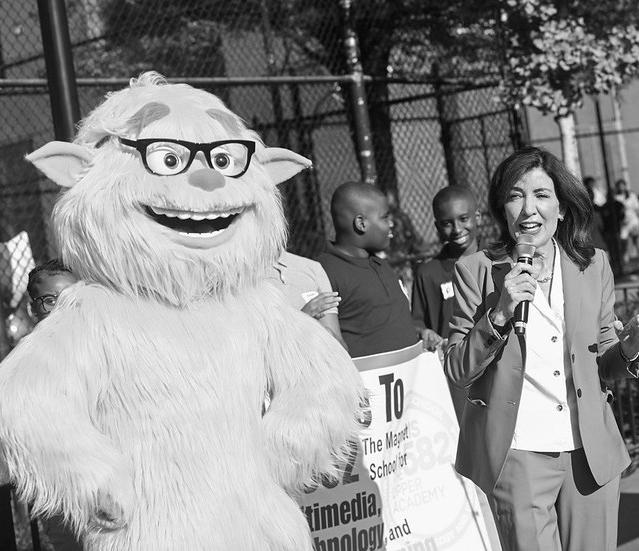
Beyond the concern for safety it is important to note that the ban cost $25 million to instate across New York. This includes the investment into Yondr pouches (magnetic sealed pouches that keep students’ phones secure during school hours) and the implementation of new rules in schools. This is a high price to pay to keep phones out of the hands of students, especially when looking at the dozens of other issues with America’s education system. Lowered federal funding, less teachers and learning gaps can make it hard to stomach the spending on phone restrictions.
Hochul and Frankie together are trying to convince the public that the phone ban is in
the best interest of students, and I was initially convinced that restrictions on phone use in school would lead to a better learning experience. The concern with phone usage is a real one and should be addressed by school administrations, with policies that could teach students how to manage the distractions they will face for the rest of their lives. But we need to properly address safety concerns before we can build solutions. Although cell phone use is a prevalent issue, students need fewer reasons to be afraid in order to make this new ban more broadly accepted.
Uma Petzke, FCRH ’29, is a psychology major from San Francisco, California.
Hochul recently debuted Frankie Focus, a mascot for the phone restrictions.
COURTESY OF SUSAN WATTS/OFFICE OF GOVERNOR KATHY HOCHUL
ISABELLA DEROSA/THE FORDHAM RAM Studying abroad allows students to partake in many opportunities.
The Dangerous Myth of ‘Transgender Ideology’
By STUART CREMER OPINION EDITOR
In the wake of high-profile acts of gun violence, people are unfortunately quick to jump to conclusions. It’s disappointing to see people take advantage of that and turn such tragedies into political ammunition, using them to attack their political opponents. President Donald Trump, for example, rushed to blame “the radical left” for Charlie Kirk’s murder mere hours after his death, before a suspect had even been named. In the days after, rather than admitting the baselessness of that claim, the Trump administration removed a reputable peer-reviewed study from the Department of Justice’s website that showed right-wing extremists are responsible for the majority of deaths attributable to ideologically-motivated violence.
These kinds of baseless accusations become drastically worse when the accusers begin to target groups more specific than just the vague “radical left.” In particular, “transgender ideology” is often blamed for instances of gun violence. The Wall Street Journal reported that Charlie Kirk’s killer was motivated by “transgender ideology,” a statement they later had to retract, contributing to the idea that transgender people are somehow inherently violent. It took two whole days for Utah Governor Spencer Cox to clarify and correct this statement. Even then, Cox continued on to publicly suggest that Tyler Robinson, the perpetrator,
was somehow “radicalized” by his transgender roommate. FBI Director Kash Patel, Fox News, Donald Trump Jr., Elon Musk, Steven Crowder, Rep. Nancy Mace and Laura Loomer all made similar claims in a desperate attempt to tie Robinson’s violent acts to some spectre of “transgenderism.”
This is not new. It happened in the wake of the shooting at Annunciation Catholic Church. It happened after the 2023 shooting at the Covenant School in Nashville, when these kinds of anti-transgender conspiracy theories started gaining popularity in rightwing circles. Even when mass shooters have no connection whatsoever to transgender people, transgender bystanders still get blamed, such as in the 2022 Uvalde shooting. And out of all these bad actors, many of whom have repeatedly lied to the public in order to amplify transphobic rhetoric, almost none have been held accountable or have officially retracted their statements. In a media environment so saturated with this despicable rhetoric, an uninformed person could perhaps be forgiven for assuming transgender people are inherently violent. But I want to be very clear about this. There is absolutely no credence to these claims. Over the past decade, the nonprofit Gun Violence Archive has recorded 5,300 mass shootings. In how many of those instances were transgender people perpetrators? Only four. The horrible actions of four individuals are
apparently sufficient justification for many to label all transgender people as inherently violent.
There is no evidence to suggest that transgender people commit violence at higher rates than their cisgendered peers. In fact, transgender people are four times more likely to be victims of violent crime than cisgender people. Furthermore, mass shooters are disproportionately men. Do we suggest taking away guns from all men? Do we claim “male ideology” is the cause of America’s gun violence epidemic? No, of course not, because gender identity is not a cause of gun violence. The data actually shows that what most mass shooters have in common are traumatic childhoods, easy access to firearms and a lack of social support.
Clearly, though, Trump and his political allies don’t care about the real causes of gun violence, exemplified by the slashing of funding for gun violence prevention. Republicans, in general, downplay how easy access to firearms contributes to gun violence, and they are less likely to see gun violence as a problem. For many right-wing political figures, these tragedies are merely political ammunition for them to use in their perpetuation of a hateful agenda. Under this warped worldview, it doesn’t matter who died, as long as Trump can use their death to try to ban transgender Americans from owning guns. Or as long as White House Deputy Chief of Staff
Stephen Miller can use gun violence to suggest that there’s a “domestic terror movement” tied to the Democratic Party and transgender people that needs to be aggressively dismantled. Or as long as the Heritage Foundation can use gun violence to propose that the FBI should label “transgender ideology” as a domestic terror threat.
The demonization and scapegoating of transgender people is a politically-savvy move for these unscrupulous politicians. It has allowed Trump to mobilize conservatives and drum up support for controversial uses of presidential power. In an article by The Trace, Ilan Meyer, a senior scholar at University of California, Los Angeles’ School of Law who has researched violence against transgender people, said, “‘The right’s scapegoating fits a historical pattern,’ and that portraying a small, vulnerable community as a threat is a tactic that’s ‘as old as stigma itself.’”
To see the effect of this kind of rhetoric, you can look to the Human Rights Campaign. They report that, in 2023 and 2024 combined, over 1,000
bills discriminating against queer and transgender people were introduced across at least 14 state legislatures, and over 100 of those bills were passed into law. Predictably, violence against transgender people has become an epidemic, rising dramatically in recent years. What’s happening here is far simpler than some would make it out to be: The Trump administration and his political allies are grossly distorting the public perception of these tragedies in order to foment hate against transgender people. They are seeking to label even criticism of violent, antitransgender rhetoric, such as Conservative Political Action Conference speaker Michael J. Knowles’ call to “eradicate” transgenderism, as “nihilistic, violent extremism.” By now, it should be clear that “transgender ideology” is merely a dog whistle that signals a violent, hateful desire to deny transgender Americans the life, liberty and happiness that all people deserve.
Stuart Cremer, FCRH ’26, is an English major from Mountain View, California.
Big Business Will Not Melt Ben & Jerry’s

By MOLLY O’CONNOR DIGITAL PRODUCER
Ben & Jerry’s has just lost a crucial member of its ice cream team as co-founder Jerry Greenfield resigned from the company last week. While it is very hard to see him go, his choice to stand on his principles is entirely commendable and one that we all should be inspired by.
Though their product has always been delicious ice cream, Ben & Jerry’s has long been known for their outspoken activism for social and
environmental justice. On the company’s official website, they repeatedly stress that, “We love making ice cream—but using our business to make the world a better place gives our work its meaning.” Their parent company, Unilever, however, does not seem to appreciate this central message and, according to the founders themselves, has worked to silence them on their political action to appease people in power.
After starting up in 1978 and going public in 1984, Ben & Jerry’s was not very lucrative
for its investors, with the stock hovering around $17. So, while it seemed unprecedented for such an outspoken independent company, Ben & Jerry’s agreed to be purchased by Unilever for $326 million in 2000. While this came as a shock to many customers who supported the brand for their famous activist voice, cofounder Ben Cohen was told that he would become a bigger part of Unilever’s social action initiatives, and he assured the consumers that he was “excited about this next chapter.”
Unilever convinced Cohen, Greenfield and other Ben & Jerry’s executives that this business deal would be one that would not only support their current social justice initiatives but promote them to the larger corporate world. Though once they got deep enough into it, management changes at Unilever took away the people who signed the original deal, and the new management used their corporate power to silence them, striking down the delicious chocolate core of the Ben & Jerry’s company.
Due to the tensions this deal has caused for a number of years, Greenfield decided it was
his duty to leave the company in protest. Cohen is in full support of Greenfield’s departure. He said that he is “glad we’re both standing up for the values of Ben and Jerry’s,” and “I think that I can be most helpful from the inside and Jerry’s going to try to be helpful from the outside.”
I believe that every company should be as socially responsible as Ben & Jerry’s. Political involvement from companies is not rare, but showing it honestly on the surface is. The fact is, corporations run our country, and if we had their support on social issues, the world would be a much safer and more equitable place. Companies should first and foremost focus on providing for their consumers, not just profitable gains for their shareholders.
As a longtime lover of the Ben & Jerry’s company, it is difficult to decide how I should act in accordance with these struggles. With my mom being a Vermonter, we have always brought the delicious taste and honorable values of their ice cream into our household. It’s the best ice cream on the market that tastes even better because you don’t have to feel guilty for
supporting the corporation.
Like Cohen, I wholeheartedly support Greenfield’s actions; the very foundation of the company he built is crumbling, and he has to take a stand. While Cohen works within the company to fight against this restrictive partnership, Greenfield is showing consumers from the outside that the founders will not stand for this blatant reduction of their company’s purpose. Consumers need to use their voices to stand against corporate silencing like this and show that they love Ben & Jerry’s because of their social mission, not in spite of it. If we allow them to be silenced and squashed under the steeltoed boot of Unilever, we will be making a statement that corporations can do whatever they want, regardless of the wants or needs of the consumer. Honest and transparent companies like Ben & Jerry’s are few and far between, so it is absolutely dire that we fight alongside them to keep their mission going.
Molly O’Connor, FCRH ’28, is an English major from Weymouth, Massachusetts.
Ben & Jerry’s co-founder, Jerry Greenfield, recently left the company.
MOLLY O’CONNOR/THE FORDHAM RAM
LGBTQ+ activists have long fought scapegoating of transgender people.
COURTSEY OF MONICA HELMS
CULTURE
Michelangelo’s Brings Boiler Room Night To Arthur Avenue
By EMILY TONNA EXEC COPY EDITOR
To some, the idea of a Boiler Room set conjures images of sweaty basements, room-shaking 808 drums and crowded, tough-to-please audiences standing mere inches from the DJ. The intimacy of such a setup can be a turnoff to partygoers that favor the impersonality of typical haunts within the Lower East Side. However, deep within transportation-deserted venues in Brooklyn and Queens, Boiler Room set culture thrives, bringing individuals together under low ceilings and well-chosen tracklists. And this past Saturday night, on the terrace of the unassuming Michaelangelo’s of Arthur Avenue, was Fordham University’s very own Boiler Room set night featuring student DJs!
1ST GEN, an entertainment company that is dedicated to encouraging individuality in the music industry, hosted the event. With upcoming events in university-centric cities and communities such as Dallas, Texas, Bethlehem, Pennsylvania and Santa Clara, California, they have fostered community through empowering young musicians. One of these creatives was Izzy Randazzo, FCRH ’28, who was approached by an organizer for the Michaelangelo’s event
after her DJ set at Howl At The Moon, where she plays every Friday.
Randazzo began her DJ journey the summer before her first year at Fordham, stating that she is entirely self-taught. “My main incentive behind teaching myself was this: if all men across the world were thriving in the EDM and DJ scene, why couldn’t I, a music-loving girl, do it too? The rest is history,” she said.
The venue is a hidden terrace reminiscent of Italy’s “trattorias,” nestled in the back of Michaelangelo’s. Chairs and tables from the day’s restaurant patrons make way for an open dance floor; purple washes of light illuminate ruddy brick walls and the DJ booth stands at the heart of the patio.
As the first track dropped, people trickled in, slowly garnering a small yet steady group of enthusiastic EDM fans. True to Boiler Room style, the music started shifting the crowd’s attention center-stage, tightening the atmosphere. Newly arrived friend groups gingerly center around the booth, creating an intimate bubble of people moving in tandem with electrifying dance-wave hits.
Performing a lively mix of 2000s hits and house tracks, Randazzo kept the crowd moving alongside a bill of other young DJs. High BPM cuts,
such as Crystal Waters’ 90s hit “Gypsy Woman (She’s Homeless),” seamlessly transition into one another, developing a sense of collective effervescence throughout the now-packed venue.
What began as a tight-knit, intimate listening experience had evolved into a performing artist’s dream, with a crowd of anticipatory students waiting for entry just outside Michaelangelo’s, spilling out onto Arthur Avenue.
“My experience as a DJ at Fordham has been incredible … There are always different kinds of nights and different crowds, and I love meeting new people and forming new connections through DJing.
I’ve grown close with the staff at Howl and gotten to know a lot of the Fordham undergraduate class,” Randazzo reflected.
Randazzo also stated her thoughts on the implications the event has for the future of Fordham’s community, commenting that she thinks 1ST GEN’s involvement is “huge for our social scene.” In the aftermath of iconic Arthur Avenue joints Mugz’s and Last Call’s closures, many students have been left wondering what the social scene of Fordham will look like now. I know I have.
However, if Saturday night was anything to go by, not all hope is lost (or pinned on the chance of Howl having a cover
fee under $20).
From the kinetic energy culminating from both the crowd and artists all night to spirits unshaken by the latenight drizzle, it’s clear that Fordham’s social scene faces an optimistic prognosis.
Because of the unique community energy of Boiler Room sets, Randazzo has high hopes for reinvigorating Fordham’s nightlife: “I hope the event brings people together and expands our social events beyond just bars and house parties. I would love to do more events like this in the future, because I love my job and I love connecting with the Fordham community.”
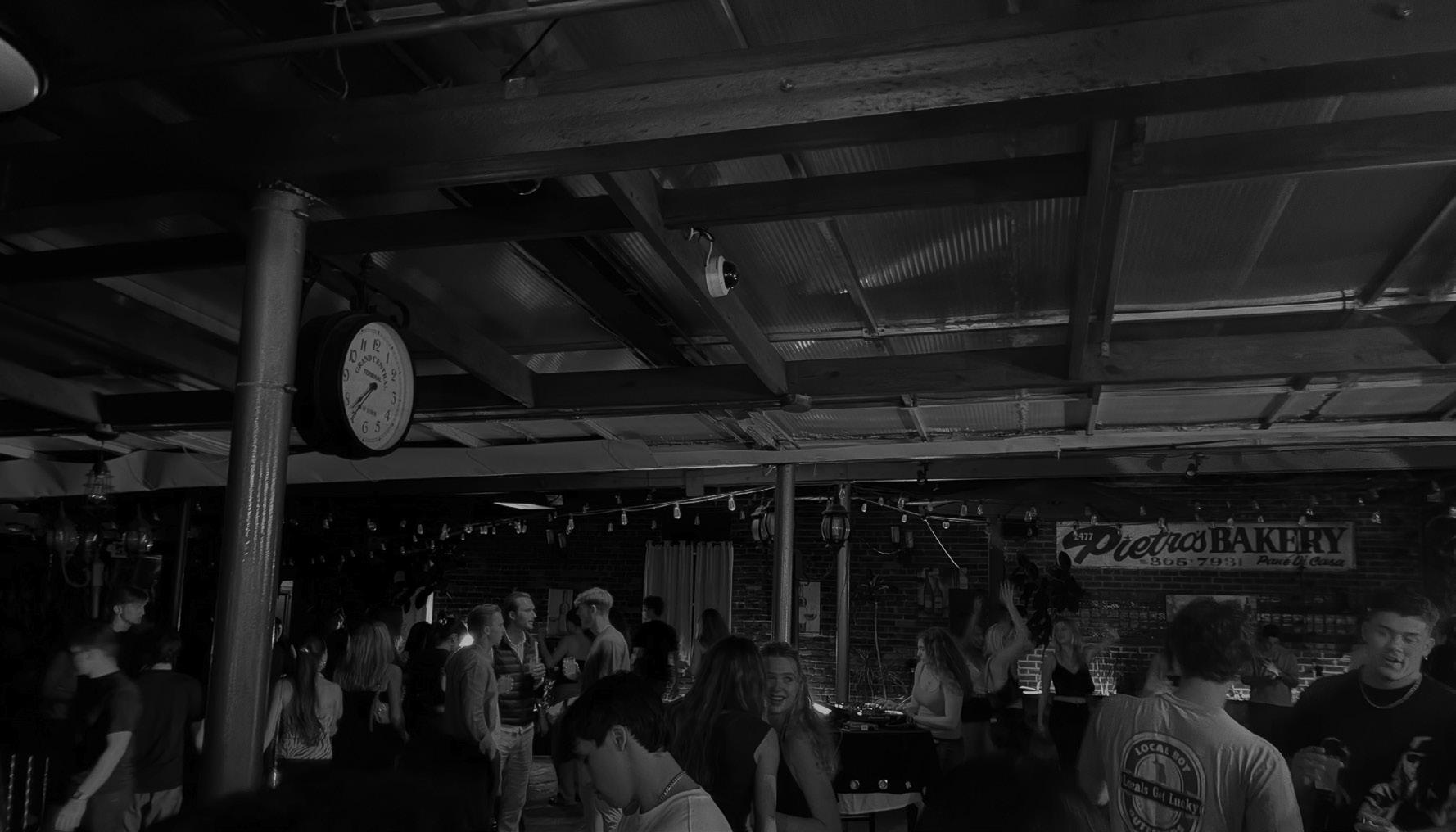
Experiencing Music in New York City
By MIA BATTISTA CONTRIBUTING WRITER
New York City offers an almost endless number of opportunities to experience live music and entertainment. You might pass local musicians serenading you at the train station, or on the street, during your daily commute. You might hear someone playing a familiar tune on a public piano at an outdoor park. Perhaps you scored sought-after tickets to an arena concert or theater performance. There’s something electric about sharing space and time with a room full of complete strangers who are equally as passionate about the music as you are.
As an avid music listener, I try to see a handful of concerts every year. I have been to a variety of venues and I have noticed how each space curates a unique atmosphere and type of show. A challenge at hand is choosing between hundreds of live events happening in the city every night. Madison Square Garden (MSG) and Joe’s Pub are two venues that have stood out to me.
Joe’s Pub at The Public Theater is an intimate space
where one can enjoy a meal or have a drink over a live performance. The room is filled with tables and chairs surrounding an elevated stage in the corner. It holds a seated capacity of nearly 180 people. I saw Em Beihold play a solo acoustic set of her original songs on an elegant grand piano. I remember hearing the rumble of a train pass beneath the room throughout the show. I had a lovely time eating my veggie burger and fries while hearing her play hits like “Numb Little Bug.” While simple and small, Joe’s Pub fosters deeply powerful and personal performances in a relaxed setting.
In contrast, MSG is an arena that hosts some of today’s top artists for high energy and larger scale productions. With about 19,500 seats, MSG can accommodate impressive set pieces and additional stages. Last year during the GUTS tour, Olivia Rodrigo sang “Logical” and “Enough For You” from a hanging crescent moon set piece that moved across the arena. Two years ago, boygenius surprised the audience by performing four unreleased songs from their extended play, “The Rest,” on a B-stage near the back of the arena. MSG promotes a wide
range of popular artists in a vibrant and loud atmosphere. I always have a blast singing and dancing along to my favorite artists with my friends there.
Concerts provide a rare opportunity to give your full undivided attention to a piece of music. For this reason, I recommend arriving early to see the opening acts perform. They often make a similar type of music as the headlining artist. For instance, I was introduced to Katie Gavin’s solo album when she opened for Lucy Dacus at Radio City Music Hall. The songs had more of a folk and singersongwriter sound than MUNA, the band she is a part of. I was impressed by Gavin’s ability to play a variety of instruments, including piano, guitar, violin and a shruti box. Concerts are a great way to discover new artists you might enjoy listening to.
Live performances carry an authenticity and unpredictability that cannot be replicated by listening to a sound recording through headphones. That being said, rising concert ticket costs can be a common barrier to entry. You can find free or discounted shows at various places, such as Bryant
Park, Central Park, Hudson Yards, Lincoln Center, Times Square and Carnegie Hall. I have seen a notable lineup of artists, including Conan Gray, during the annual Global Citizen Festival on the Great Lawn at Central Park. You can earn free admission by taking action towards important global issues. Fordham features student performers and popular artists through Spring Weekend at Rose Hill and Winterfest at Lincoln Center.
Over the years, I have enjoyed seeing artists like Ashe, Ricky Montgomery and Role Model on campus.
New York City provides so many different events to experience music and art in a live environment. I’m looking forward to seeing The Favors at SummerStage this week and Ingrid Michaelson at the Irving Plaza in December. Music creates a special sense of connection and community among those who listen together.



MIA BATTISTA FOR THE FORDHAM RAM Music in New York City fosters community in parks, theaters and student events.
EMILY TONNA /THE FORDHAM RAM
Students pack into Michelangelo’s terrace for Fordham’s Boiler Room night.
CULTURE
‘Living
By LALLEYAH CAMARA ASST. NEWS EDITOR
Before there was “Friends,” there was “Living Single.” While not always mentioned alongside the more popular ’90s sitcoms, the cultural impact of “Living Single” remains undeniable. The show first aired in 1993 on FOX, capturing the beauty of friendship, ambition and Black excellence. It follows six young people chasing their dreams in New York City, long before shows like “Sex and the City,” “Friends” and “Insecure” followed suit.
A celebration of Black excellence, “Living Single” is simply about successful Black adults navigating life, falling in love, building careers and dealing with the pains of adulthood. It is an honest, refreshing and affirming rendition of what it looks like when television does not rely on stereotypes or tokenism. Instead it presented a range of Black identity and personality, something quite rare for its time. Be it through Maxine’s sharp-wit, Synclaire’s whimsical optimism or Khadijah’s entrepreneurial drive, the series allowed Black women to be
Single,’
The Underrated Sitcom of the ’90s
seen as layered, multidimensional human beings.
The show is nothing short of iconic in this aspect, as it centered Black characters in an industry known to reduce them to sidekicks or comedic relief. Its powerful display of friendship and ambition within a Black cast, living in a Brooklyn brownstone in a diverse neighborhood, laid the groundwork for future ensemble sitcoms with similar themes.
One of the many reasons “Living Single” remains iconic is its rich cast. Khadijah James (Queen Latifah) is the confident leader of the group, who is a self-employed magazine editor. Maxine Saw (Erika Alexander) is a high-powered attorney who is brilliant, sarcastic and proudly owns her sexuality quickly, becoming a fan favorite. Regine (Kim Fields) brought style and ambition, while Sinclair, (Kim Coles) cousin to Khadijah, offered heart and humor through her quirky and slightly naive outlook on life.
The men of the series — Kyle (Terrence C. Carson) and Overton (John Henton) — were not just add-ons. Instead, they were full of
personality, wit and humor, often challenging traditional ideas of Black masculinity. The chemistry between the ensemble remained magnetic as the dynamic felt eternally genuine, even through television screens.
The show does not need to rely on gimmicks or heavyhanded social commentary to make a point. It has a perfect balance. It is smart without being preachy, and funny without being shallow. Watching the cast in action, you will notice the sharp writing, filled with quick one-liners and cultural references. It tackles social issues like gentrification, workplace discrimination and dating double standards, all while keeping things light and entertaining.
Another point of “iconicness” in the show is that it never felt like it was performing for a white audience, unlike many sitcoms of the time. The humor and wit, deeply embedded in the show, was all rooted in Black culture. It didn’t dilute itself for mainstream approval. This unapologetic authenticity is a huge part of why the show resonates for so many today.
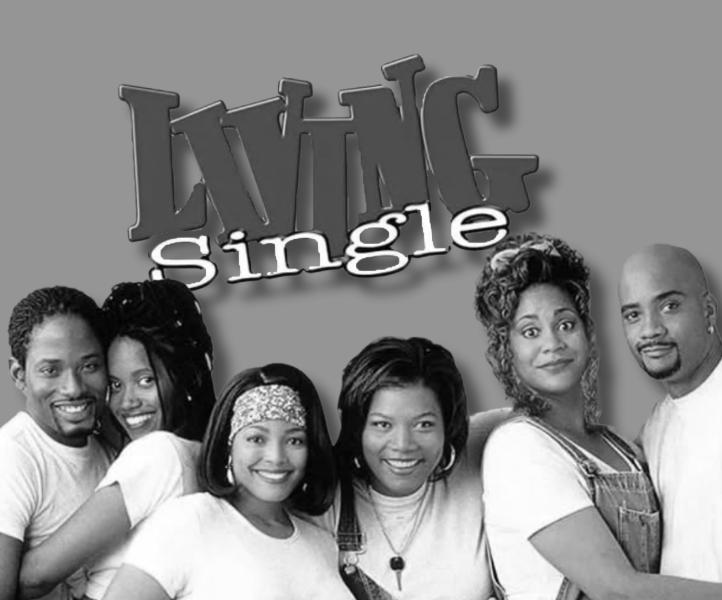
It is impossible to talk about “Living Single” without acknowledging its influence on other shows. In fact, “Friends,” which premiered a year later, borrowed heavily from its premise. That is, six 20-something friends in New York City, dealing with life in a shared space. What is the difference? “Friends” became the global phenomenon we all know and love, while “Living Single” remains underappreciated by mainstream media, despite its
Who’s That Kid?| Maria Giannopoulos FCRH ’28
strong ratings and devoted fanbase. Thanks to streaming platforms and an evernostalgic generation, “Living Single” has been receiving its flowers more recently. A new generation is discovering not only how meaningful the show is, but a different era of trends and style. From iconic fashion moments to iconic catchphrases to iconic archetypal characters still in media today, the iconic “Living Single” influence is everywhere.
Maria Giannopoulos Learns to Reconnect With Her Roots
By LORESA ZEQIRAJ ASST. OPINION EDITOR
For Maria Giannopoulos, FCRH ’28, being at Fordham University has given her a college experience she might not have been able to get anywhere else. While she’s only a sophomore, Giannopoulos has discovered new things about herself and her heritage, as well as hundreds of hidden neighborhoods in the city. Both of her parents are of Greek descent, and while Giannopoulos has been to Greece herself, something she found right here at Fordham has brought her closer to her culture. The Fordham Hellenic Society, otherwise known as the Greek Club, has allowed Giannopoulos to become more involved in the community and meet other students who share a similar background as her. While this might seem like it’s just a fun way to spend time throughout the week, this club means more to Giannopoulos.
Being a part of the Hellenic society became an opportunity for Giannopoulos to learn ethnic dances. She said her favorite experience since joining was Greek Night. “Starting in the winter, the dancing troupe members would practice a variety of different cultural dances multiple times a week to perform at Greek night during the spring. Family and friends come, Greek food is ordered in,” she said. Giannopoulos described the members to be welcoming and has made some great friends through the club. Her retelling of meetings,
events and relationships makes the Hellenic club seem like an extension of her own family.
Apart from her on-campus activities, Giannopoulos also makes the most of her free time by exploring the city. Having her campus within a much larger city was a characteristic of Fordham that really drew her in. When searching for a college that would give her the best of both worlds, with an enclosed campus and bustling streets right outside its gates, Fordham was the perfect mix.
“[It] has been such a privilege” is what Giannopoulos had to say after explaining the endless opportunities this school and city have offered her. Some of her favorite hobbies include reading and photography. This city allows her to pursue these passions and interests in conventional as well as unique ways. Giannopoulos explained that “since being gifted my own digital camera at 14, I’ve brought it with me everywhere I go, going on excursions just to grab some good photos.” Running out of new sites to see or views to capture is practically impossible in New York City. As a double major in political science and history, photographing the city is a breath of fresh air from her studies. Along with taking photos, she loves walking — especially going into Manhattan and wandering for hours. Oftentimes, she’ll embark on trips to the city to find new spots to eat or visit a new museum. Since she loves reading so much, she has recently made it

a point to find new bookstores each week. These excursions might seem easy to manage, but any college student knows that finding a way to juggle academics, social life, hobbies and responsibilities is a challenge.
Being in her sophomore year now Giannopoulos reflected on her first year of college and contemplated her journey: “I almost feel it is unavoidable but in a good way, because struggling to keep the balance will help you learn how to.” Now, during the first semester of her second year, this student has learned a lot about herself.
“While it is hard sometimes to tell people no, I have learned it is so important to set boundaries for yourself
and to listen to your mind/ body when making decisions,” she said. “I’ve learned that it isn’t selfish to take time [for] myself to relax and take care of my wellbeing … When it comes to responsibilities and academics, I make sure to allot myself time each day for work and studying, taking well-needed breaks and walks in between.”
One way Giannopoulos relaxes is by sitting on a bench near Edwards Parade and reading on her Kindle. She can usually be found with an iced vanilla latte from BKG in her hand.
Giannopoulos is an extraordinary student here at Fordham with a unique story. She has overcome the
spaces such as the Hellenic Society. classic challenges that many other college students encounter, but she has a personally inspired way of combating them. She follows her heart, unless she’s aimlessly strolling around Manhattan, then she’s not following much at all. She has found a strong community here and hopes to give back to it as much as it has given to her. Her ability to reconnect with her heritage while also embracing the vast, diverse city around her is a prime example of what students are able to do at Fordham University. Most importantly, she remembers not to neglect herself and her own hobbies and passions are still amongst her priorities.
“Living Single” ran for five seasons from 1993 to 1998.
MEGHAN CATTANI/ THE FORDHAM RAM
LORESA ZEQIRAJ/THE FORDHAM RAM
Fordham sophomore Maria Giannopoulos has found community on campus in
CULTURE
New York Botanical Garden Farmers Market: A Hidden Gem
By JULIA BURNHAM CONTRIBUTING WRITER
While walking through campus this past hot, muggy Wednesday, I was excited for the New York Botanical Garden’s farmers market. I had been searching up “farmers markets near me” only a few days before signing up to write about this, wanting to find a good place to get a bouquet of fresh flowers each week for my apartment. Though I did not wind up purchasing any flowers, they were still very much available with a plethora of options for anyone interested. I was very surprised and impressed. As I walked into the market at the far end of the garden, I was immediately greeted by a large fruit and vegetable stand. While I did not need any, I was entranced by the fruits’ bright colors and clear freshness. There’s something about farmers market fruit that feels much more real and tangible than fruit you would find at a supermarket; maybe a bit more soul and heart in it from the local farmers. Or perhaps it just feels more direct since you are able to see the people who work for the specific farm your produce was grown in as you buy it, as opposed to at the supermarket where you do not know where the fruit came from. Either way, I will definitely be back to buy fruit from
By EMILY MCCALL CONTRIBUTING WRITER
Have you ever been into a haunted house? Well, as a student at Fordham University, you might just be living in one. Fordham is known for being one of the most haunted college campuses in America, with a number of ghost stories to back it up. Being built in 1841, there has certainly been enough time for ghosts to accumulate within our many halls. This Halloween, you may not need to watch any scary movies as they could be coming to life in the room next door.
That was the case for the Resident Assistants (RA) in the summer of 2003, working in Queen’s Court before any students had moved in. During their rounds around the hall, they would repeatedly find the mattresses of the beds propped up, rather than lying flat, and despite their efforts to fix them, they would continue to find them back as they were. One night, one of the RAs was woken up to a knock on their door, and opened it to find an elderly Jesuit who stated, “Someone must have been praying pretty loudly if they got me up at this hour. Sorry about that, it normally stays at the other end of the hall,
them in the near future.
Just to the left of this fruit stand stood a honey display, with the company entitled “Boogie Down Bronx Honey.”
Unfortunately, I had already bought a large jar of honey from Whole Foods, but was very intrigued by both the bright packaging and the Bronx values that were clearly ingrained in the company. If you want a sustainable local business to support, there’s none better than that one.
If you’re going to the farmers market, it is a necessity to get food. There was an abundance of homegrown, natural options, whether you’re looking for savory meals or baked goods, or a Bronxbased juice bar I wish I was thirsty enough to try. I was particularly surprised at the amount of gluten-free options there were. Gluten-free packaged meals were available at a stand with options for all dietary needs, as well as a stand for 3x3 Kitchen, which is a completely glutenfree bakery with a permanent location in Riverdale. I, of course, had to get a pizza babka from them. If you have celiac disease like I do or eat gluten-free for any reason, the NYBG farmers’ market is the place for you. I’ve found my farmers markets back home in Illinois are inclusive to dietary needs, but I wasn’t
sure if this mindset would translate to a smaller market like this one; I was very happy it did. As someone who is often too busy or tired to cook an elaborate meal, having healthy options to reach for is especially critical. It’s far better for your diet when your meals aren’t always store-bought frozen ones.
If you’re not gluten-free, word on the street is that there’s usually a delicious bagel stand at the market, though it wasn’t there when I went.
Food was not the only option at this farmers market. Other selections included a Little Free
Library, a jewelry stand and a little clothing shop. Overall, there was a diverse selection of items that included far more than just produce. What makes this particular farmers market different from others is the location. Tucked away in the botanical garden, it is hidden to those who don’t know about it, and a well-kept secret of those who do. Though it may not be bustling with vendors like suburban farmers markets, its intimate, cozy feeling may actually be its best feature.
Walking back to the NYBG gift shop and then my dorm, I
was quite tired and sweaty, but very satisfied with what I got. There is a wide array of foods and other goods for different tastes, and all three of the items I got are still sitting in my freezer right now as I write this piece.
Overall, I really enjoyed this farmers’ market, and I plan to go back each Wednesday until it closes on Oct. 22. Everyone should check it out at least once, if not for the products, then for the overall good vibes and friendliness of both the patrons and the staff. There are only three weeks left, so visit while you can!
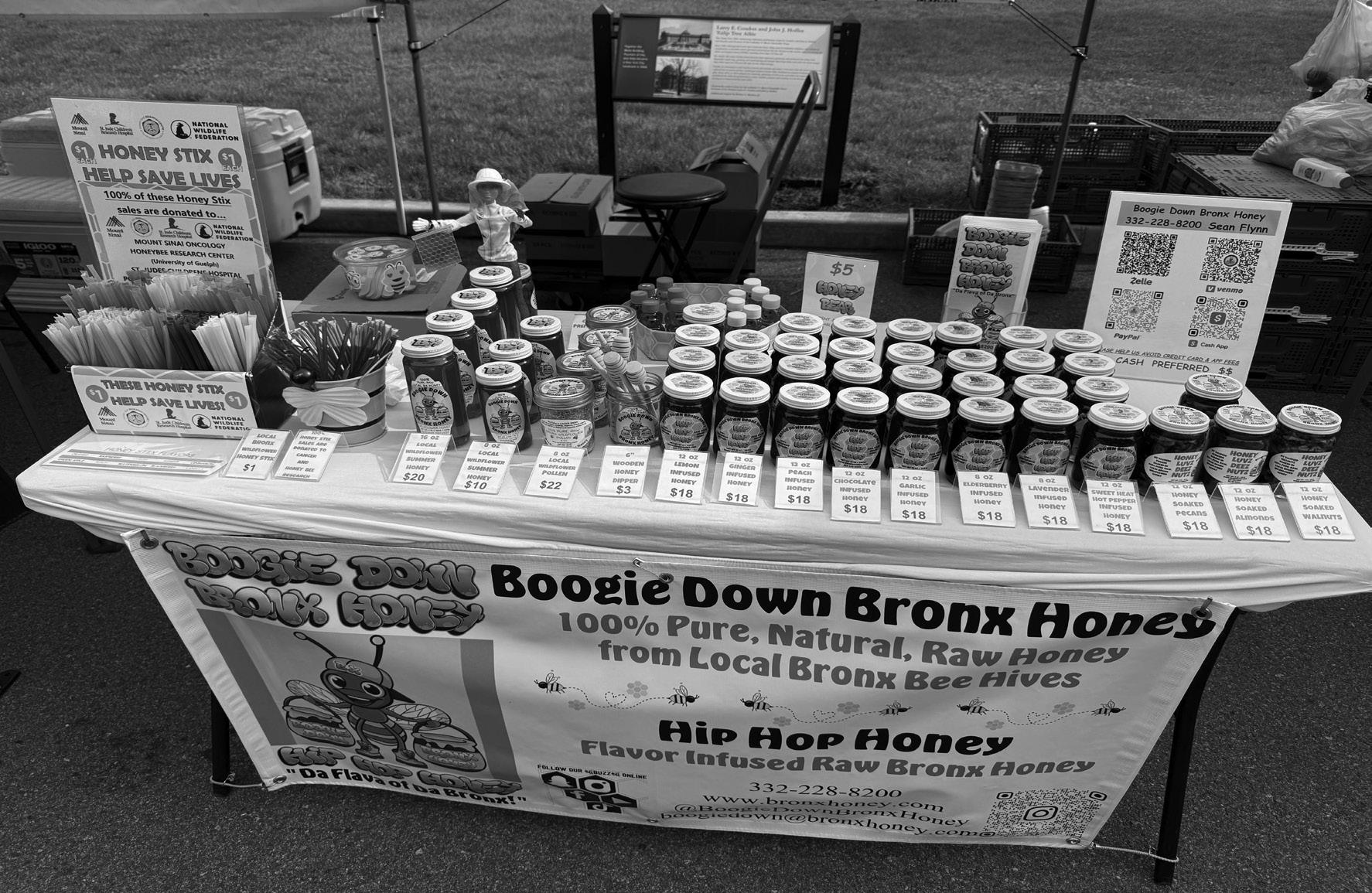
Stories of a Haunted Campus
but it must have gotten out. Don’t worry, I took care of it.” From that night on, the RAs never found the mattresses in the wrong position again. Thankful for the helpful Jesuit, the RA sought him out. However, when they described the man, they found that the Jesuit matching that description had died 10 years earlier. What had this undead Jesuit done to cast out the spirits that had haunted the halls of Queen’s Court?
The reasons behind the hauntings is unknown, but in Finlay Hall, there is certainly a history that could have been the cause of all these unexplainable events. Prior to becoming a dorm, Finlay was the location of Fordham University’s medical school. The basement of Finlay was also home to a large number of cadavers used by students for their studies. Today, students have reported waking up to seeing figures leaning over the lofts in the room watching them. Some have even stated that they have felt cold hands choking them or pulling at their feet, as if they were a cadaver being tagged.
These frightening tales have certainly given Fordham a spooky reputation. Even the producers of “The Exorcist” chose to film in our very own
Keating and Hughes Halls. This film follows the story of a young girl who developed odd behaviors and was later declared to be possessed by the devil. A few of the scenes were filmed in both basements which has led to even more urban legends surrounding these halls. In Keating Hall, for example, students have experienced the feeling of being watched or even have felt a hand tap them on the shoulder when there is no one there. Had the filming of this bonechilling movie left an entity behind in our halls or did this uneasy feeling linger within Keating since the beginning?
Even this year students have reported paranormal activities such as LED lights randomly turning red in the middle of the night or hearing strange noises outside their door at a time when there is typically no one awake. Is this the fault of electrical wiring and sharing a residence hall with so many other students, or is there more at play here? Could it be that all of these stories passed down through the years are true and the campus is really haunted? Either way, people have taken the precautionary measures of signing up to have their room blessed just in case there were ghosts still lingering somewhere in their room.
If you are looking for a good
scare this spooky season you may not need to go far. From the ghostly Jesuit wandering the halls to the knowledge of what had laid in the basement of Finlay before it was turned into a dorm, there are urban legends lurking
around every corner. Each hall has its own story that has been passed down between generations of Fordham students. The question is are you brave enough to go looking for them, and what you will find if you do?
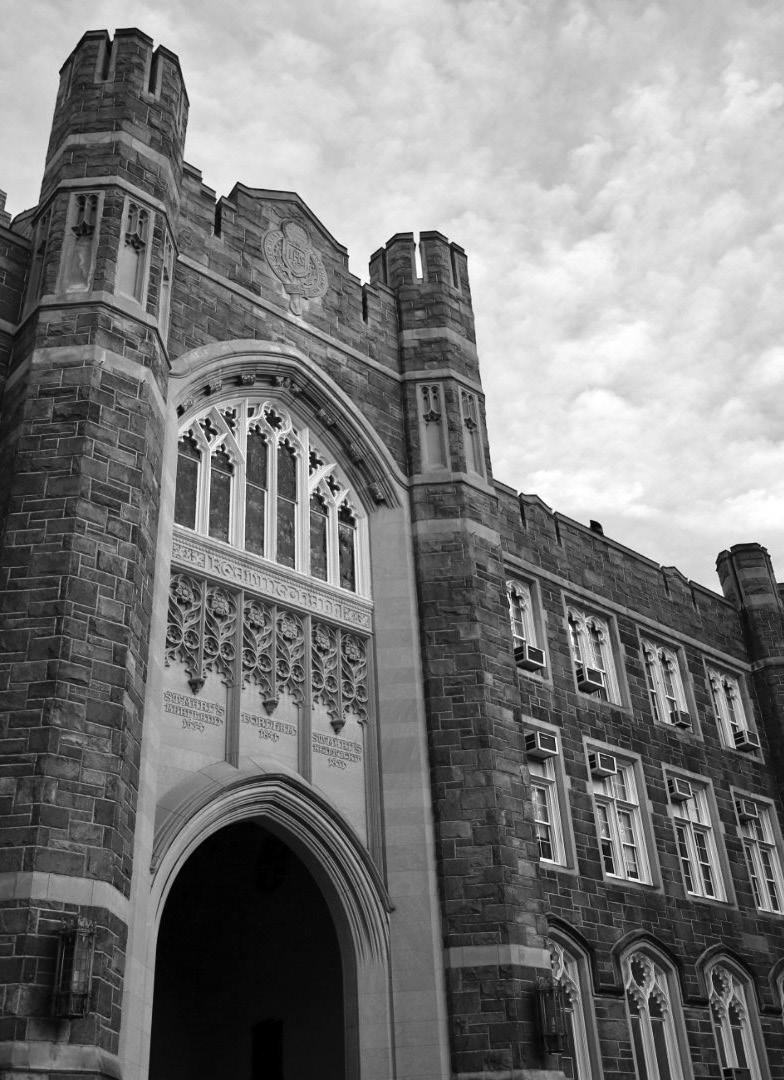
MARY HAWTHORN/THE FORDHAM RAM
JULIA BURNHAM FOR THE FORDHAM RAM
Fresh produce and other goodies greet visitors at the New York Botanical Garden’s weekly farmers market.
Fordham University’s Keating Hall is rumored to house ghostly legends.
October 1, 2025
CULTURE
Do You Really Know Your Mind?
By MARIAM AHMED CONTRIBUTING WRITER
I honestly don’t believe we fully grasp the immense potential within us. Our mind harbors all of our solutions and successes, yet we fail to filter out the fears, the negativity and the doubt that seems to surpass our mental strength. This book offers you insight on how to defeat these issues, strengthening your sense of self while simultaneously increasing your knowledge. It is safe to say that the knowledge acquired from this book can only be as useful as you allow it to be. I say this because the application of the methods and techniques reviewed in the book will change the trajectory of your life in subtle yet distinct ways. Although this book is titled “The Magic of Believing,” I’m here to inform you that there are multiple phenomena in psychology as well as personal case studies that support the ideas discussed in this book. That being said, nothing requires you to make any extravagant sacrifice in your life, but it targets the trivial matters we view as fleeting. In this, we discover that our weaknesses stem from daily habits we don’t realize may be leading to our downfall. We, as a collective, utilize repetition, but are we actively assessing what we’re repeating? Are the thoughts
we’re consistently cultivating negative or positive? Do we actually believe the success we’re working towards is already ours? Are we dreaming too small? These are only a few questions to consider in the light of reflection associated with this book. It might sound silly, but do you ever find yourself being critical when significant things fail to go as planned? It’s easy to be doubtful especially since society has ingrained in us that unwavering faith might just be a mask of delusion. “The Magic of Believing” counteracts this in every way possible; of course, if you truly believe in the successes examined and the stories shared. Slowly, various perspectives we neglect in daily life such as writing things down and repeating positive affirmations that align your conscious with your subconscious will seem doable in the journey to achieve unwavering accomplishment. I’m a firm advocate for the idea that everything stems from belief, and if you reflect on that within the scope of your own life, you might grasp why it makes sense. We often receive things because our belief that it will be obtained is so innate, we fail to entertain any thoughts of doubt regarding it. For instance, we believe we’re going to eat everyday, because no matter what, a meal will always find its way

to us, no matter its source. Silly, I know, but the aspects we often don’t think about are what should be given some thought. If we can trust that food will always find its way to us, then why can’t we apply that same certainty to every other aspect of our lives?
To create the life we truly desire, we must first believe it’s possible. It seems simple, but it’s almost ironic how much space we give to doubt, while rarely filling our minds with the same certainty of
success. “The Magic of Believing” emphasizes the various quotes you observe on social media but are accompanied by personal stories increasing its validity. We undermine our own value and power when we bask in self-doubt and fear, disregarding that our mind is the true powerhouse of freedom and happiness.
This book teaches you to control your mind before it controls you and maintain a level of faith that’s seemingly unshakable. You’ll gain tools to transform
how you make decisions, deepen your self-belief, shift your perspective on negativity and turn it into positive energy, all while boosting confidence in achieving your goals and setting new ones. Although I’m highlighting only a few methods, the results speak for themselves. Over time, these habits will transform the opportunities you attract, allowing you to embody magnetism and fulfillment that once felt out of reach.
Stars, Sequins and Social Media: The DWTS Comeback
By JOHANNA BROOSLIN CONTRIBUTING WRITER
After a record-breaking 33rd season, “Dancing with the Stars” has returned with its 34th season, carrying forward the momentum and fan enthusiasm that revitalized the series. Alfonso Ribeiro and Julianne Hough return as the season’s co-hosts, alongside the judging panel of Carrie Ann Inaba, Bruno Tonioli and Derek Hough.
The season premiere of the reality dance competition saw strong viewership numbers, with 8.13 million total viewers across all platforms after three days. The popularity of the show has grown thanks to the presence of the dancing pros on TikTok, specifically Riley Arnold and Ezra Sosa, as well as the program’s expanded reach on Disney+ and Hulu. After the popularity of last season, more and more of the stars and pros are posting on social media to get audiences involved, causing the 20th anniversary of the show to be its most popular year yet. After almost being canceled a few years ago due to low ratings, the program’s rapid growth comes as a surprising comeback and cements the show’s place on the network for the time being.
The season 34 cast of stars
showcases a diverse range of talent, bringing together actors, musicians, influencers athletes and more. This year’s lineup includes Jen Affleck, Hilaria Baldwin, Jordan Chiles, Baron Davis, Alix Earle, Dylan Efron, Corey Feldman, Danielle Fishel, Elaine Hendrix, Scott Hoying, Robert Irwin, Lauren Jauregui, Whitney Leavitt and Andy Richter.
With the first two weeks underway, there are already a few clear front runners for the highly coveted Mirrorball Trophy. From “The Secret Lives of Mormon Wives,” Whitney Leavitt, paired with pro Mark Ballas, has already shown much promise by tying for the top of leaderboard both weeks. She has previous dancing experience, growing up dancing in Utah and receiving a dance degree at Brigham Young University (BYU). Tied with her is wildlife conservationist and fan favorite Robert Irwin, partnered with Witney Carson. Despite having no formal dance training, he is one of the most impressive stars so far. Although this should come as no surprise seeing how his sister, Bindi Irwin, competed and won the Mirrorball back in season 21. Judge Derek Hough even called Irwin’s week one jive to “Born To Be Wild” by
Steppenwolf the best first dance he had ever seen. Rounding out the frontrunners is social media influencer Alix Earle with Val Chmerkovskiy. Although not currently on the top of the leaderboard, Earle’s talent and potential, combined with a strong fanbase, makes her a strong contender.
Despite only being two weeks into the competition, the judges are already catching heat this season for their scores. Many fans believe the first few weeks are too early for judges to be giving the contestants sevens and eights, feeling higher scores must be reserved for more polished performances later in the season. Some say that giving out high scores so quickly makes it difficult for the judges’ scores to reflect the contestants’ growth throughout the season, and instead causes the performance scores to be stuck in the same range for many weeks at a time. This was a big complaint last season, and unfortunately, the pattern seems to be repeating in season 34. As the season progresses, fans can look forward to a variety of theme nights such as Disney Night, “Wicked” Night, Halloween Night and more. These themes influence the music, costumes and dances chosen by the pros, keeping
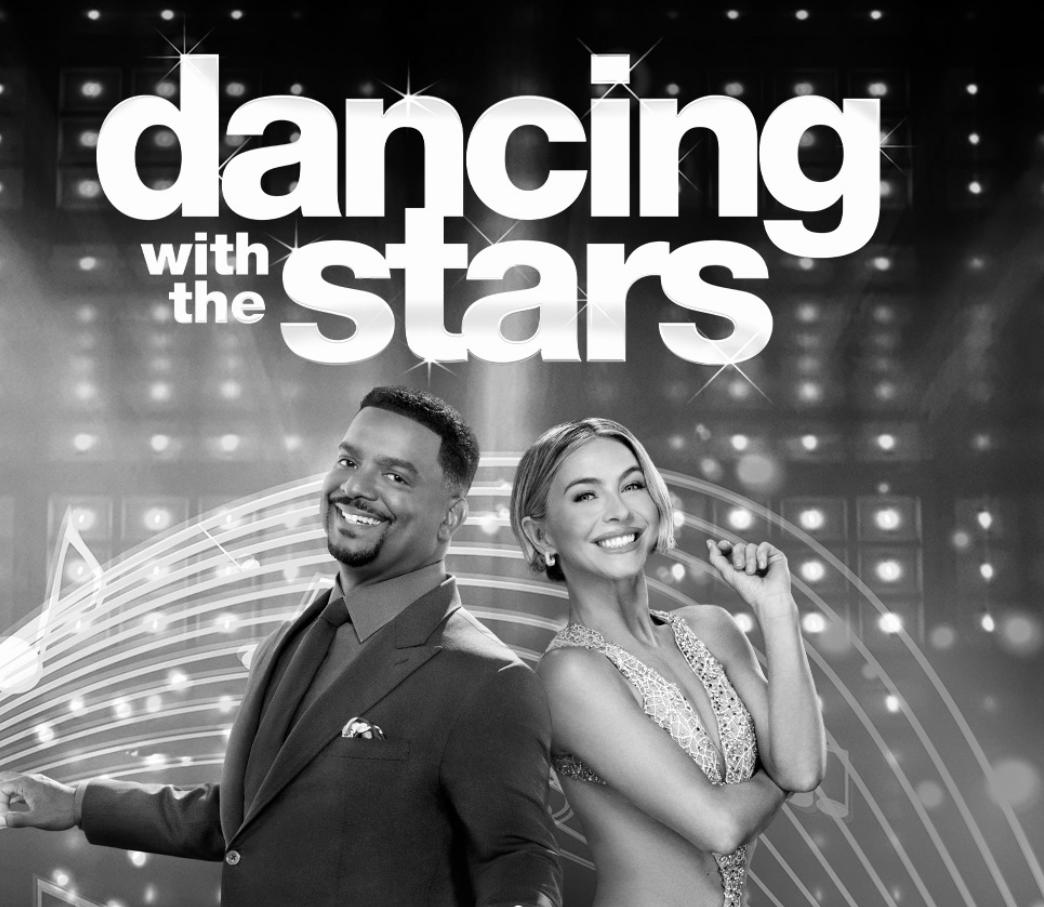
“Dancing with the Stars” airs Tuesdays at 8 p.m. EST on ABC and Disney+. were sent home. The night itself, however, was filled with fun and memorable performances all around. Even after tearing her hamstring during rehearsals, “Boy Meets World” actress Danielle Fishel danced through the pain and delivered a solid Cha Cha with her partner Pasha Pashkov. Other standout performances came from Hilaria Baldwin’s Tango and Jordan Chiles’ Jive. With so many talented and interesting personalities in the cast, we can expect a very exciting and unforgettable season ahead.
fans engaged. Many are already speculating as to what music the celebrities will be dancing to for each of these nights, especially for the highly anticipated Disney and “Wicked” Nights. While there were no eliminations on premiere night, the following week’s “One Hit Wonders Night” raised the stakes with a double elimination. After combining the judge’s scores with the viewer votes from the first two weeks, Baron Davis and Britt Stewart along with Corey Feldman and Jenna Johnson
MEGHAN CATTANI / THE FORDHAM RAM
“The Magic of Believing” reminds readers that the mind may be our most powerful tool.
‘Sixties Surreal’: Reality Turned Unreal
By ELISE GRIN
CONTRIBUTING WRITER
On Wednesday, Sept. 24, I had the pleasure of experiencing the “Sixties Surreal” exhibit at the Whitney Museum of American Art. After lamenting about delays on the 6 train and trudging through a bustling Chelsea on a clammy day, I wanted nothing more than to fully immerse myself in another time period through Surrealist art that would make me question not only where I was, but what I was a part of. And, yes, the expansive exhibit did precisely that.
After making my way to the fifth floor, I entered a room with nothing but an elongated tangerine wall and three daunting, unnervingly lifelike camels: “Camel VI,” “Camel VII” and “Camel VIII.” Having not yet read the placard, I couldn’t help but wonder what camels could have to do with the American ’60s. Whenever I enter a museum, I challenge myself to refrain from reading the placards before viewing the art, wishing to draw my own interpretations and frame the pieces in a context that I can understand or come to myself. This begs the question: Should we interpret art solely in its own political and sociocultural context, or is art meant to be personalized to the viewer? I try to engage with a little of both, precisely what I did throughout the “Sixties Surreal” exhibit. But there was
something about the camels that I could not wrap my head around, and thus, I spent a good while pondering the placard nearby. I concluded that this piece astutely sums up the intention and implication of 1960s Surrealist art.
Nancy Graves, the artist who sculpted these camels, once expressed that “camels shouldn’t exist.” We have all heard that form follows function, and despite their unorthodox anatomy, this idea rings true with camels. Though seemingly absurd, the traits that make camels seem so otherworldly or odd are exactly what make them well-adapted to their harsh, arid environments. Graves created a sculpture so realistic that one may believe it is taxidermy, but she challenges this by using a combination of other materials, reminding us that what meets the eye may not be all there is. Though form may follow function, having one logical purpose is often insufficient in maintaining one’s identity during turbulent, seemingly illogical times. Absurdity, as counterintuitive as it may seem, may be the very thing that keeps us all sane.
Many historians believe that Surrealism’s origin lies in the shortcomings of Dadaism, a post-Great War movement centered around irrationality, anarchism and anti-war sentiments. From Dada arose Surrealism in the minds of 1920s Parisians such as André
Breton and Louis Aragon, who believed Dadaism to be “politically directionless.” Drawing from the works of Sigmund Freud and other French psychologists, Surrealism aimed to forsake the constraints of social convention by operating through the subconscious and inner identity. “Sixties Surreal” demonstrates the vitality of disintegrating the status quo during a time when reality is so unrelenting and bleak that all one can do is become the exact opposite: colorful, eccentric, revolutionary, anti-establishment and what appears to be absurd in the minds of those creating this devastating reality.
In another room, “If All the World Were Paper and All the Water Sink” depicts an observer of an apocalyptic scene. A nuclear mushroom cloud encircles a distant city, enclosed by the Greek letter omega, symbolizing the end, the last or fulfillment, and in this case, nuclear destruction. Meanwhile, at the front of the scene children hold hands and dance despite their collective fate. Many characterize 1950s America with a high anxiety surrounding nuclear weapons, setting the framework for the artist Jess’ conglomeration of distress. In May 1961, national television broadcasted President John F. Kennedy encouraging the creation of a national shelter program after several 1950s nuclear tests displayed high radiation levels.
The widespread fear devolved into ominous, gloomy views of the future amidst an unstable political climate. In Jess’ piece, the dancing children’s innocence juxtaposes a certain death, which is surreal, yet it also represents protest and revolution by their mere existence. Can innocence, unintentionality and absurdism coexist with purpose and function? The answer is yes, and “Sixties Surreal” proves this. My brain conjured up the song “When the World Was at War We Kept Dancing” by Lana Del Rey. Del Rey sings of an America consumed by
governmental dissatisfaction of many citizens, pondering whether it’s the “end of an era” in America or if there will be a “happy ending.” Del Rey concludes, “When the world was at war before / We just kept dancin’.” Despite the clash between optimism and pessimism in the verses, a confusing, frustrating and seemingly unreal reality is ultimately accepted, imitating Graves’ oxymoronic message in the form of three camels. With these lyrics still relevant for me in 2025, I suppose we all must keep dancin’.
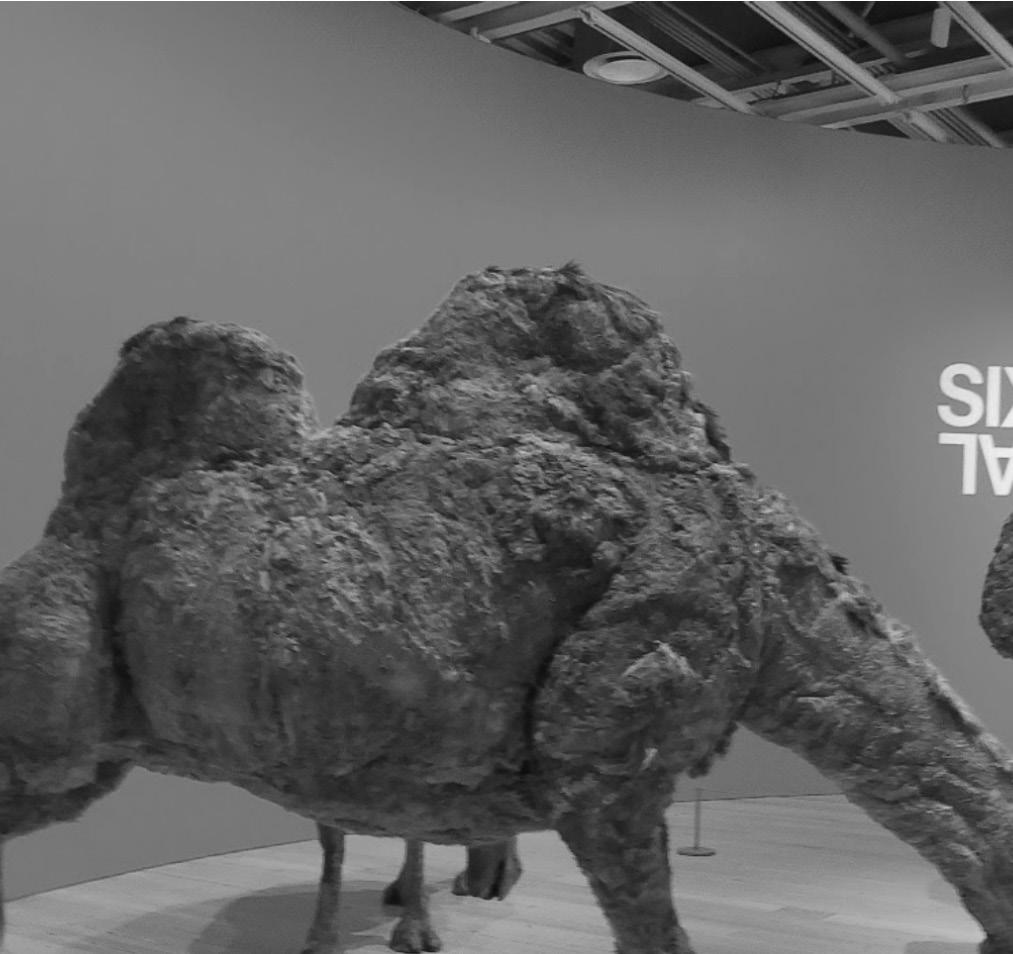
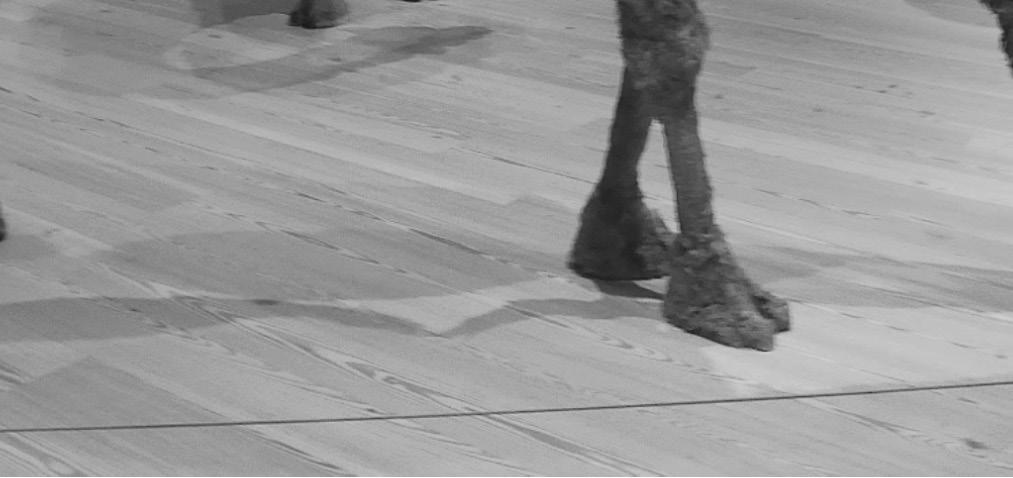
The Fordham Ram Crossword



ELISE GRIN FOR THE FORDHAM RAM
Nancy Graves, “Camel VI”, “Camel VII” and “Camel VIII”, 1968-69, mixed media.
Volleyball Takes Set Off Defending Champs
By JOE HENRY
EDITOR EMERITUS
After a head-turning 6-4 start to the season, Fordham University Volleyball lost twice at home last weekend to the defending champion Loyola University Chicago (LUC) Ramblers to open the Atlantic 10 (A-10) season. While the Rams might not be keen to celebrate anything short of a match win, they did do something they hadn’t done against LUC in 34 years: win a set.
The feat proves what became evident about this team two weeks ago — they are capable of making a top-six finish and making the A-10 playoffs, even after finishing last in their conference in 2024 and graduating many of their best players.
After being picked to finish 10th out of 10 teams in the A-10 in the preseason poll, the 2025 Rams have adopted a defensefirst identity and rewritten program records through four weeks of play — but that doesn’t mean that the road back to the postseason will be easy.
On its home floor against the Ramblers, Fordham fell 3-0 on Friday, 25-21, 25-19, 2522; and 3-1 Saturday, 25-18, 25-23, 22-25, 25-18. The Rams took time to shake off their first conference game jitters in the opener, and fatigued as play wore on Saturday, dropping to 0-2 to start A-10’s
for the second straight year — but don’t get carried away comparing Fordham to its 2024 self.
The last time Fordham took a set off of Loyola Chicago was in a 2-3 loss in 1991. No one on the 2025 roster had been born yet. George Bush was president — the first one.
While they’ve only met seven times since, Fordham’s ability to keep pace with a league perennial powerhouse — one that crushed Fordham en route to a conference championship 10 months ago — confirms what Head Coach Ian Choi already knew: this year is different than last year.
“Our juniors are mentioning how this third year is probably the most cohesive year that they’ve experienced in their time at Fordham … There’s just a stark difference between a cohesive team and an incredibly cohesive team, and we’re the latter this particular season,” said the eighth-year head coach.
“It’s very fortunate for our first years, because they’ve walked into something pretty special,” he said.
A big reason for optimism is the team’s health. Junior Tatum Holderied, who missed nearly all of last season with injuries, on Saturday set a new program record for blocks in a four set match with 12. She now holds the single game record for both four and five set matches. Holderied’s 2.33
Athletes of the Week
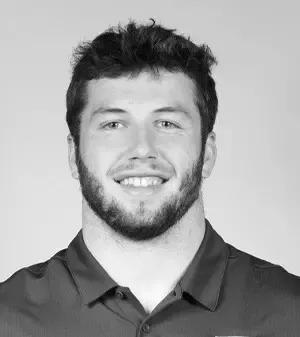
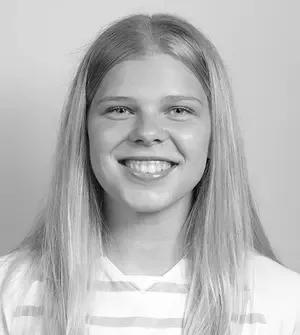
In Fordham University Football’s 26-21 victory over College of the Holy Cross to secure the 2025 Ram Crusader Cup, junior linebacker Andrew Osmun was crucial in securing the win, the Rams’ first of the season. On top of his 10 tackles, Osmun intercepted a pass by Holy Cross quarterback Braden Graham with nine seconds left in the fourth quarter. The pickoff stopped Holy Cross’s final drive and ensured a Rams win, snapping their eight-game losing streak to the Crusaders.
In a 4-1 Fordham University victory over the Saint Joseph’s University Hawks, sophomore forward Liina Tervo led the way. She opened the scoring in the 10th minute with her seventh goal of the season, which leads the team. She also scored the final goal of the game in the 71st minute to secure her third multigoal game of the season and the fourth of her career. Tervo also notched an assist to total five points on the day, her highest point total thus far this season. Tervo also scored the only goal in a Rams win over the University of Richmond. She was named Atlantic 10 Offensive Player of the Week for her efforts, her second award of the season thus far.
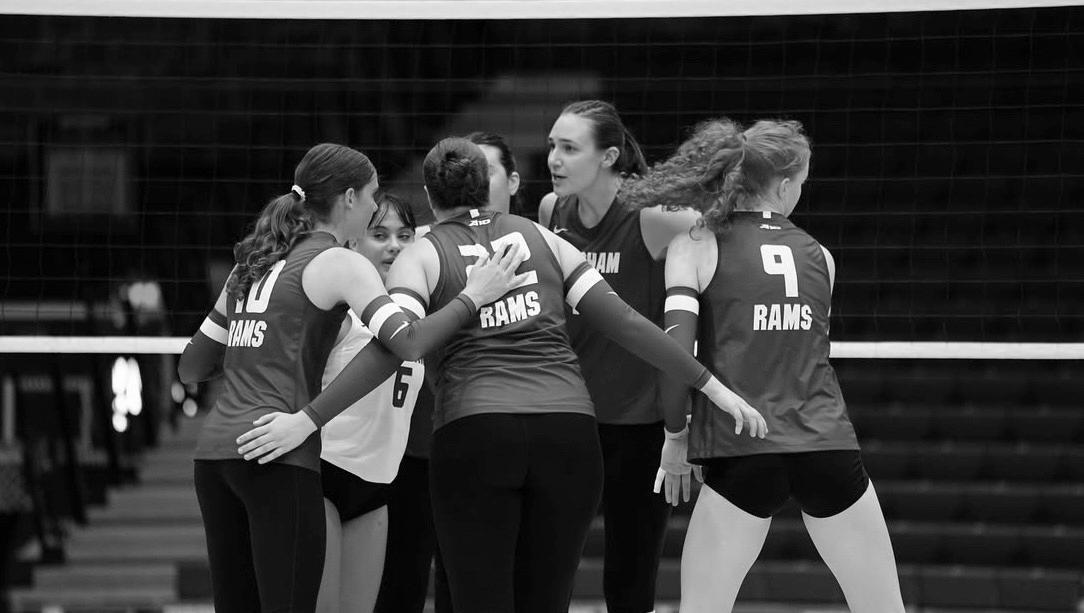
blocks per set are the most in the country by a margin of 0.44 — she’s posting half-a-block more per set than the second best blocker in the country.
Sophomore middle blocker Sophia Kuyn, who spent part of last season in a walking boot, is averaging 0.98 blocks per set and leading all Rams with a .252 hitting percentage.
Both middles have formed fully-sealed walls with senior Audrey Brown, whose 1.48 rightside blocking rate continues to be the top mark in the country. As a team, the Rams extended their program-record streak of matches with 10+ blocks to nine, adding 11 and 17 versus Loyola.
In Friday’s loss, Fordham committed brutally timed service and attacking errors; but even in its narrow victories, Loyola looked like something it never previously had: beatable.
Before the weekend, Choi said, “the overall consensus [among players] was: they’re
beatable. We can beat them. And this is the first time they’ve said something that definitively about Loyola.”
While Fordham only beat Loyola in one of seven sets, the evenness of the overall competition was telling.
Junior Erynn Sweeney buoyed the Fordham attack, hammering Fordham’s final three kills in its historic set three win over Loyola Saturday, while logging 12 total putaways to lead the team. Choi is now taking a bycommittee approach at outside hitter, with sophomore Gabby Destler moving into a timeshare with Sweeney and senior Zoe Talabong.
Sophomore Özge Özaslan continues to star in the back row, notching a team-best 34 digs over the weekend.
Junior libero Lola Fernandez, meanwhile, has been earning more reps — Choi credited Fernandez for “elevating the standard” during practices,
noting that the decision on who to start at libero each match is “basically a coin flip.”
Despite the losses in the opening weekend, the tone on Rose Hill continues to be hopeful. “Last year, there was this tentativeness and concern. But this year’s message was: you don’t own what you can control, and let go of the things that you can’t,” stated Choi.
Fordham faces yet another major test this weekend when they visit the University of Dayton, where the Rams will take on a Flyers squad that finished 12th in the national Rankings Percentage Index in 2024. The trip to Ohio marks Fordham’s first trip outside of New York thus far in 2025 — the Rams went 2-11 when playing outside in the Big Apple last year.
This weekend’s matches will be broadcasted on ESPN+ Friday at 7 p.m. and Saturday at 1 p.m.
Varsity Calendar
Andrew Osmun Junior Football
Liina Tervo Sophomore Soccer
ASST. SPORTS
It had been 34 years since Fordham took a set off Loyola Chicago, until this weekend. COURTESY OF FORDHAM ATHLETICS
Call Under Review, ABS is Here to Stay
KURT SIPPEL STAFF WRITER
In 1876, the first professional umpire called the shots in the first National League game, and back then, teams only paid them $5. Now, with new technology, robotic umpires are checking in for a shift behind the plate for Major League Baseball (MLB).
At the beginning of next season, the MLB will be implementing an Automated Ball and Strike system (ABS) challenge system into the game. Both teams will have two challenges per game that they can keep if they win the challenge. Teams will also get one in extra innings if they have none left.
Challenges can be initiated by the catcher, the batter or pitcher. When a player decides to challenge an umpire’s call, it is initiated when the player taps on the top of their hat or helmet.
The challenge system will now be powered by a system of cameras that will allow the umpires to review the pitch in real time. When a player challenges, it will be reviewed on a video board and judged whether or not it was a ball or strike.
Fans have gotten a taste of this system leading up to next season. It was first tested in the Atlantic League in 2019 and made its way to Triple-A during the 2023 and 2024 seasons. Now, the full ABS system was replaced for the challenge system we have coming next season.
In the beginning of the 2025 season, fans got to see the ABS system in place during spring training and during the All-Star game. These two games were the first time the MLB was able to show off the new technology to a wider audience.
Other sports have been using the same system the MLB has grown to adopt. An ABS system similar to
the one used in the MLB is found in tennis and judges whether or not a ball was inside or outside of the lines. This system has been in place in tennis since 2006, almost two decades before baseball made an attempt at similar technology.
The set up for the ABS system will be the width of the home plate, 17 inches. At the top end of the strike zone, there will be 53.5% of a player’s height and at the bottom of the strike zone, it will make up 27% of a player’s height. This new way to track pitches will also track the length of home plate, 8.5 inches.
Even though this ruling seems positive, it did not pass unanimously. The MLB Competition Committee brought up some concerns that the Players Association (PA) has about the system.
The MLB Competition Committee was made up of six MLB-appointed members, four active players and one active umpire, so input was key throughout the whole process.
“I think with any sort of technology, there’s not 100% certainty of the accuracy of the system,” said Yankees outfielder Austin Slater, one of the members of the committee.
“I think the same can be said of umpires. So I think it’s just coming to grips with the impact that technology is going to have and whether or not we were willing to live with that error that was associated with the system, even if the error is very, very miniscule,” he said.
According to the UmpScore card, when Major League umpires call pitches, they are 94% accurate. The MLB also says that the addition of robot umps will cut down on ejections — 61.5% of ejections last season were over ball and strike calls.
The questions around the system also brings up concerns about framing pitches, and having that element removed
from the game entirely with the new challenging system.
San Francisco Giants catcher Patrick Bailey feels like this will emphasize the size of the batters strike zone instead of relying solely on framing.
“I think it’s a bummer for catchers across the league,” Bailey told the Athletic. “But I don’t think it’s going to take away the value of framing. You still have to get calls and keep strikes (as) strikes. At the end of the day, I still think it’s going to be really valuable to know the zone.”
While the MLB has not fully committed to the robot umpires just yet, this is just the beginning of new technology implementing itself further into the game.
The new additions of the ABS system will challenge the umpires to be better and call pitches more accurately than before. The players will have to be more responsible when watching out for the right pitches, and knowing what pitch is actually worth the challenge.
In the league’s 288 spring training games where the ABS system was being used, calls got overturned 52.2% of the time; catchers had correctly challenged 56% and were most successful. Batters did not fall far behind, winning 50% while pitchers challenged 41% of the calls successfully.
This ABS system is going to add a new layer to the game. It is going to hold everyone more accountable and make games come down to razor thin margins. That will show who is really paying attention.
Like everything, some fans and players will love the new technology and some will hate it. Whether fans and players like it or not, the game is going to change, and everyone will be pushed to adapt to the changing landscape of the MLB.
Men’s Tennis Hofstra Invitational (No Individual Scoring)
9

Football Gets First Win of the Season vs. Holy Cross
LEAH RENSHAW CONTRIBUTING WRITER
On Sept. 27, the Fordham University Rams picked up their first win of the 2025-26 season, beating longtime Patriot League rival College of the Holy Cross Crusaders 26–21 at Moglia Stadium in the annual Ram–Crusader Cup game. Both teams were seeking their first win, but Fordham came out strong and held on late to end an eightgame losing streak against the Crusaders.
Fordham started fast, scoring just 58 seconds into the game when running back Ricky Parks broke free for a 45-yard touchdown run. Quarterback Gunnar Smith added a twoyard rushing touchdown later in the first quarter, and early in the second, he connected with wide receiver Nodin Tracy for a
31-yard touchdown pass, giving Fordham a 20–7 lead.
Holy Cross scored twice late in the second quarter to grab a 21–20 advantage going into halftime, but Fordham returned from the locker room with renewed energy, something their supporters had been eager to see.
The Rams’ defense tightened its coverage and shut down the Crusaders’ rushing attack, forcing a quick three-and-out that shifted momentum back their way.
Smith directed a balanced series of short passes and runs, keeping possession and wearing down their defense.
Kicker Bennett Henderson then delivered in the crucial final moments, connecting on field goals from 36 and 35 yards to restore the lead and assert Fordham’s control of the game as the home crowd erupted in cheers.
The Fordham defense stepped up in a big way. Linebacker James Conway, a graduate student, led the team with a career-high 19 tackles. With those tackles, he became the first Patriot League player and only the sixth in Football Championship Subdivision history to achieve over 500 career tackles.
The win not only ended Fordham’s long losing streak against Holy Cross, but also set an encouraging tone for the rest of the season. With Smith leading a steady offense, Henderson making key kicks and Conway powering a tough defense, the Rams showed the determination and balance they had been looking for since the start of the year. As they move into conference play, Saturday’s victory proves that Fordham is ready to compete and turn its season around.
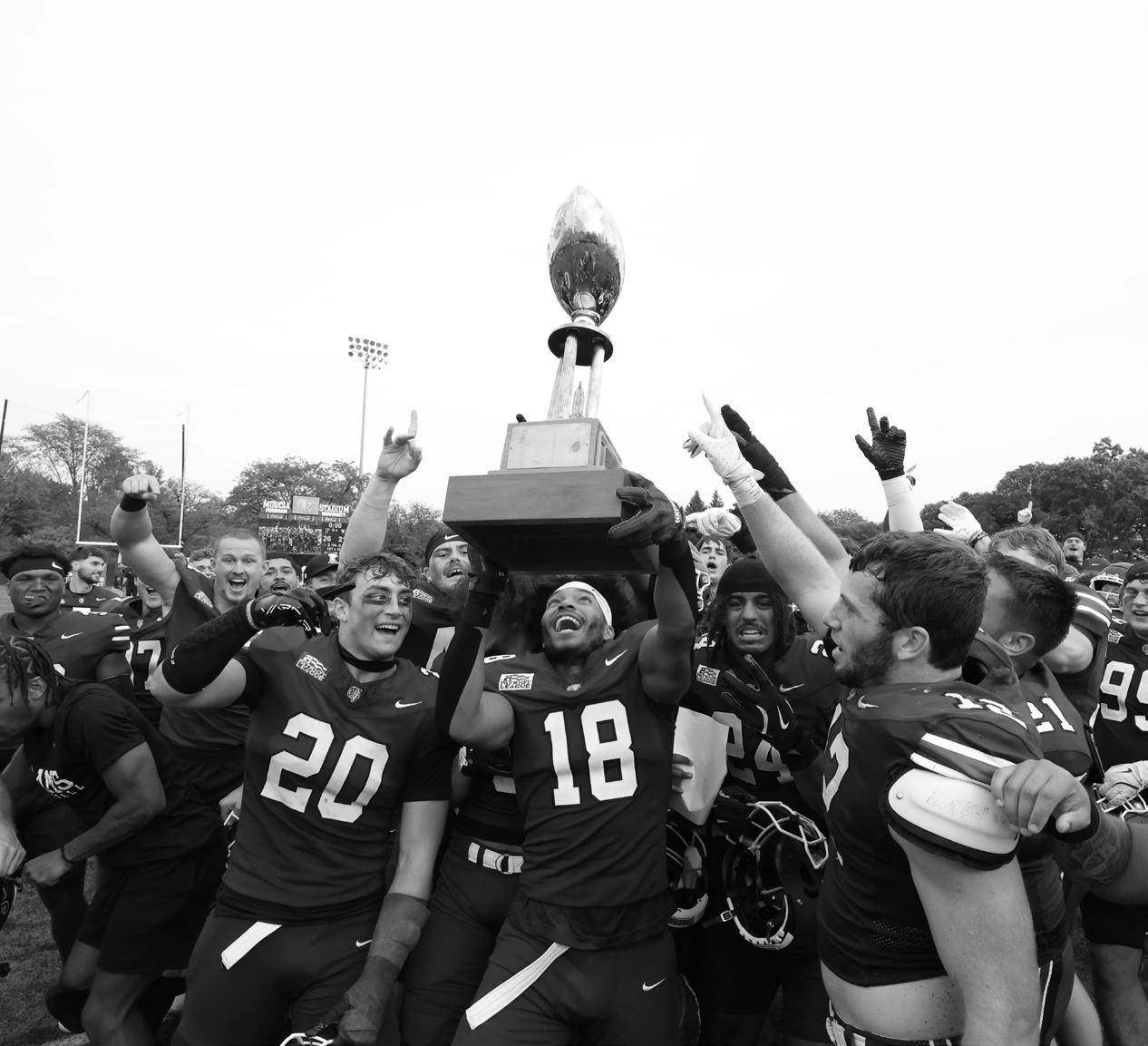
Compiled by Ian Nelson, Asst. Sports Editor
CRISTINA STEFANIZZI FOR THE FORDHAM RAM
Members of the Fordham football team lift the Ram-Crusader Cup after defeating Holy Cross.
COURTESY OF @SPORTSNET
Blue Jays centerfielder George Springer argues with an umpire over balls and strikes.
Remembering Three Legendary Goalies
By GRACE MCCARRON SPORTS EDITOR
As we approach a new season on the ice, a bittersweet feeling has engulfed the hockey world. Ken Dryden, Eddie Giacomin and Bernie Parent, three Hall of Fame goaltenders from one of the sport’s best eras, have passed away in the month of September.
Dryden died on Sept. 5 after a battle with cancer. Dryden led an illustrious life both inside and outside hockey. As the Montreal Canadiens’ goalie from 1971-79, he won six Stanley Cups, including their four straight victories from 1976-79 and five Vezina Trophies for the league’s best goalie. In his rookie season, he won both the Conn Smythe Trophy for playoff most valuable player and the Calder Memorial Trophy for Rookie of the Year.
A critical piece of the Canadiens’ dynasty that helped establish them as the most successful franchise in the NHL, Dryden’s impact was felt far beyond the sport of hockey. He has been hailed as one of the best representatives of Canada both during his hockey career and his time in public service after hanging up the skates. He served as Minister of Social Development from

2004-2006 and as a member of Parliament from 20042011. He penned several books, the most famous, 1983’s “The Game,” receiving a nomination for the Governor General’s Award and gaining recognition as a must-read for hockey devotees. He also dabbled in broadcasting, and was on the call for one of the most legendary sports moments in American history during the 1980 “Miracle on Ice” run to the gold medal for the U.S. Olympic team. Canadian Prime Minister Mark Carney paid tribute to Dryden on social media: “Few Canadians have given more, or stood taller, for our country. Ken Dryden was Big Canada. And he was Best
Canada. Rest in peace.”
Local legend Giacomin, who passed away on Sept. 14, became a model of consistency and grit during his nine seasons as the starting goaltender for the New York Rangers. From 1967-70, he led the NHL in games played, and led in shutouts in 1967, 1968 and 1971, sharing the Vezina with teammate Gilles Villemure in 1971. Rangers fans might cringe at the memory of Giacomin being placed on waivers and claimed by the Detroit Red Wings following a slow start to the 197576 season. He returned to Madison Square Garden two days after joining Detroit, which made for a highly
emotional and memorable moment as the Blueshirts faithful chanted his name before the national anthem and booed when their own team scored on Giacomin.
The Red Wings won the game, and it’s now remembered as one of the greatest moments in the illustrious history of the Garden. He is a member of the 1987 class of the Hockey Hall of Fame and had his number one retired by the Rangers, their second number retirement after the legendary Rod Gilbert.
Parent, who passed away Sept. 21, was beloved by the Philadelphia Flyers and hockey communities, leading the team to their first and thus far only two Stanley Cups in 1974
and 1975. Putting together two of the greatest goalie seasons of all time in a row, Parent won both the Conn Smythe and Vezina trophies in those Cup-winning seasons, when the team was nicknamed the “Broad Street Bullies” for their aggressive play style. Parent was the quintessential Flyer. His number one was retired by the team in 1979, the second number to be retired in their history. There is a statue of Parent and teammate Bobby Clarke hoisting the Stanley Cup in South Philadelphia. Whenever he made an appearance at Flyers events long after his retirement in 1979, chants of “Bernie, Bernie, Bernie!” would rock the arena. He was the first Flyer to be inducted into the Hockey Hall of Fame, as a member of the class of 1984. The 1970s NHL was filled with drama, dynasties and larger-than-life figures. These three goaltenders helped set the standard for future netminders and were representative of one of the most enticing and famed eras in the sport’s history. It’s difficult to summarize these three illustrious careers, but Dryden, Giacomin and Parent will all be remembered and mourned by every member of the hockey community for years to come.
City Connect Uniforms Are Authenticating the MLB
By MOLLY FRIEDMAN STAFF WRITER
Launched in 2021, Nike and MLB’s City Connect uniforms bring bold, alternate designs that celebrate the cultures and history of each team’s city. These uniforms feature alternative designs, color schemes and graphics that are radically different from the team’s usual attire, similar to the NBA city jersey series.
The Boston Red Sox were the first team to debut the city connect uniforms in the early days of the 2021 season. The yellow and blue color scheme, which completely abandoned the classic red, was a nod to the Boston Marathon, which usually takes place on Patriots’ Day. The uniform also features a patch on the arm reading “617,” the area code of Boston.
In the design process, designers make an effort to pay homage to the city’s cultural heritage through minute details or subtle nods. For example, in the Arizona Diamondbacks’ 2021 original City Connect uniforms, the color used for the numbering and lettering paid homage to the red rocks of Sedona.
The Milwaukee Brewers’ City Connect uniforms feature

the “MKE” on their hats, which is the airport code for Milwaukee’s airport. These graphically impressive jerseys represent that it’s bigger than baseball. The cities that our beloved teams play in make the sport what it is. Fans fuel the local economies by traveling far to attend games. The community that has been created from these fan bases stretches far and wide, allowing a divided nation to unite over a game. The City Connect jerseys bring in more fans as people see their heritage and culture represented by these players and the team.
City Connect is a refreshing breath of air for the game of
baseball. This game is one built upon tradition; it is one of the oldest sports in America. Introducing alternative ways the game is presented demonstrates how it is evolving for modern times and progressing in line with what society wants to see. City Connect is also a demonstration of the interplay between creativity and sport.
Most teams have chosen a dedicated day of the week to wear their jerseys when they play at home, mostly Fridays or Saturdays. These days often bring the biggest crowds to the stadiums, so the jerseys are shown off for
all to see. The jerseys are available for purchase at an inflated price compared to the team’s original jerseys and have become quite popular among fans.
Nike is now introducing a second City Connect design for many teams, allowing them to incorporate even more of their culture. On the opposite end of the spectrum, two teams have chosen to opt out of the alternative uniforms. The Athletics, who are currently in the process of moving cities, do not currently have a City Connect uniform. The New York Yankees have also rejected the premise to stick
with their tradition of not wearing alternative jerseys and staying in the classic pinstripes.
A few teams stand out for their uniforms, which incorporate stylish graphic design and rich culture into one. The Texas Rangers’ uniform, which debuted in 2023, is packed with Texas history. The TX logo on the front right chest is a nod to the Lone Star State. The jersey also has a reference to both their minor league teams by combining the logos into a “pleagle.”
The Houston Astros’ famous Space City uniforms are also a standout for good incorporation of the city’s history. Houston is well known for its association with NASA, so the look leans into that, as well as the font, which is “spaceinspired.” Lastly, the Detroit Tigers’ city connect uniform, which debuted last season, encapsulates the city’s history in the auto industry with the words “MOTORCITY” written on the front of the jersey. The sleek look is intended to reference the exciting future this city has ahead of it.
The addition of the Nike City Connect uniforms has been a way to bring essential culture into professional sports.
MEGHAN CATTANI/THE FORDHAM RAM
The hockey world lost three legendary goaltenders in September.
COURTESY OF @HOMEOFTHESOX
City Connect uniforms offer MLB teams an opportunity to represent the cities they reside in.
Trump & UFC CEO Confirm Event on White House Lawn
By JAMES NELSON ASST. SPORTS EDITOR
A few months after President Donald Trump teased hosting an Ultimate Fighting Championship (UFC) event at the White House, UFC CEO Dana White says the UFC has reached a deal with the White House.
“We got it done,” White said in a video he posted on social media informally announcing the event. While the exact date and matchups have yet to be announced, White says the event is locked in for June of 2026. Trump first mentioned the possibility of hosting a UFC event at the White House during a rally in Des Moines, Iowa on July 3. Trump suggested the event would have a crowd of roughly 25,000; White stated that a park nearby the White House will host a watchparty for the event holding a crowd of nearly 85,000.
White also confirmed that the event will air live on CBS and that the fighters will make their entrances
By IAN
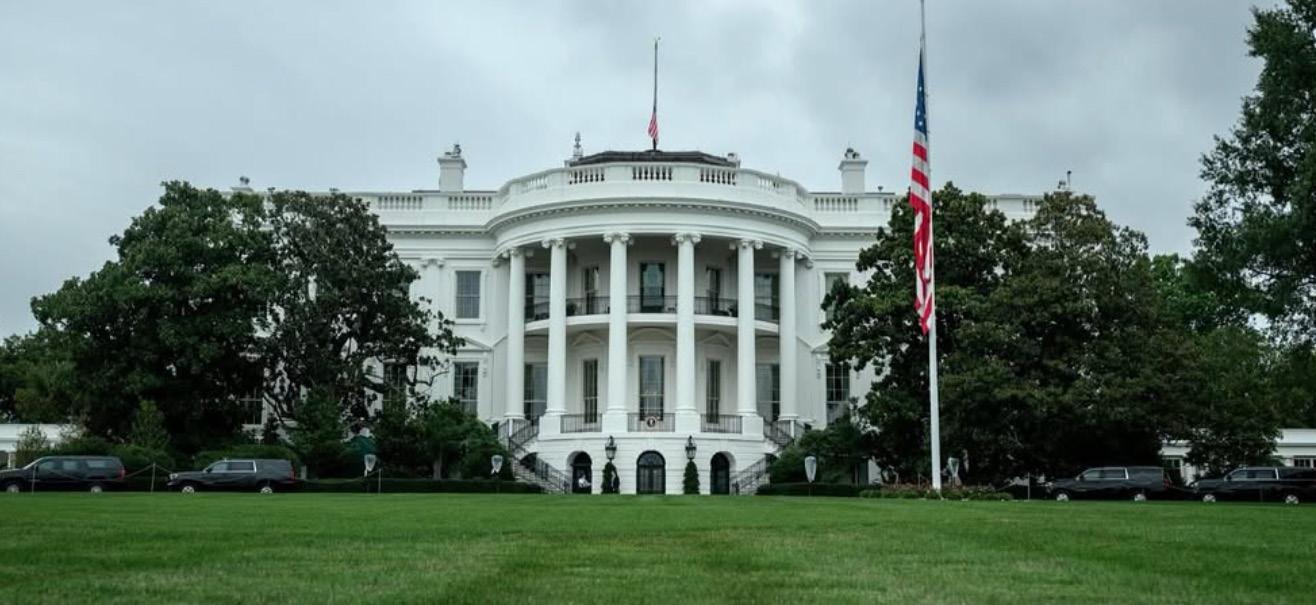
by walking from the Oval Office to the octagon. Computer renderings displaying a mixed martial arts octagon surrounded by a sizable crowd on the White House South Lawn were posted by White and the official White House account on Instagram. Trump has a longstanding relationship with White as one of the first investors in the organization. Due to the controversial nature of mixed martial arts, the UFC struggled to find venues in the early 2000s. Trump allowed
White to hold events in the Trump Taj Mahal, his hotel and casino in Atlantic City, New Jersey. Recently, Trump has been a frequent audience member at UFC events such as UFC 309 in November of last year, when he attended a fight night in Madison Square Garden alongside many of his cabinet members and Elon Musk. White and a slew of UFC fighters were present at Trump’s inauguration including the company’s top star: Conor McGregor.
McGregor, an outspoken conservative, also has ties to the Trump administration. The former UFC champion visited the White House on St. Patrick’s Day and held a short conference in which he echoed the Trump administration’s anti-illegal immigration rhetoric; McGregor stated that Ireland was on the brink of “losing its Irishness.” McGregor has repeatedly teased running for president of Ireland on social media and in interviews. McGregor has also voiced his interest in
fighting at the White House event but set a steep price tag of $100 million. Legendary fighter Jon Jones is another big name who expressed interest in the event. Jones retired earlier this year only to re-enter the UFC drug testing program upon talks of the event’s increasing probability.
Aside from the UFC event, Trump has hyped a number of events set to take place in 2026 to celebrate the 250th anniversary of American independence. Among these is the Great American State Fair, a ceremony held at the National Mall that will feature exhibits from all 50 states as well as events at several national parks. Trump also announced the “Patriot Games,” a televised athletic competition featuring the top high school athletes nationwide. From the card to the crowd size and security logistics, most details about the event remain unknown. However, White has vowed to build the best fight card in UFC history for what will be the first sporting event at the White House.
Overtime: What Makes a Hall of Famer?
On Friday, Sept. 19, Los Angeles Dodgers pitcher Clayton Kershaw took the mound at Dodger Stadium for his final regular-season home start after announcing to the world that he would retire at the end of the season. Then, on Saturday, New York Yankees designated hitter (DH) Giancarlo Stanton hit his 450th career home run (HR), bringing him closer to joining the exclusive 500 HR club. Despite each players’ impressive career, they are often viewed differently in regard to future Hall of Fame status. Kershaw’s resume is one of the best of all time for a pitcher. Over his 18 seasons in the MLB, Kershaw was an 11-time All-Star selection, the 2014 National League (NL) MVP, three-time NL Cy Young Award winner, a Pitcher’s Triple Crown winner in 2011 and two-time World Series champion with the Los Angeles Dodgers. He is also the 20th pitcher ever to reach 3,000 strikeouts, he holds a career 2.54 earned run average (ERA), which is the lowest in the live-ball era among qualified pitchers and he has the highest career win percentage (.698) for pitchers with 300+ starts. Kershaw’s longevity and dominance all but assure him a first-ballot Hall of Fame (HOF) induction.
But what about Stanton? Throughout his 14 years in the MLB, his career has been marred by inconsistency and his HOF status is a topic of debate among baseball fans. When looking back on his time in the MLB, Stanton, at his best, will be remembered as one

of the most powerful and intimidating batters ever. At his worst, he often looked lost at the plate. Propelling him toward the HOF are his NL MVP in 2017, ALCS MVP in 2024, an All-Star Game MVP in 2022, Silver Slugger Awards in 2014 and 2017, and two Hank Aaron Awards in 2014 and 2017. He is a five-time All-Star, a two-time NL Home Run Leader, an NL RBI Leader, and has recorded over 450 career HRs. If (when) Stanton reaches the 500 HR milestone he will be the 29th player to achieve this feat.
Still, when judging anyone’s career you must also consider the lows. Stanton has struggled with high whiff rates throughout his career, often swinging at pitches well outside the strike zone. He has also been a DH since 2019, causing a sharp drop off
in his wins-above-replacement (WAR). In 2018, his first full season with the Yankees, Stanton posted a 6.5 WAR across 145 while playing in the outfield. After an injury in 2019 and the shortened COVID-19 season in 2020, Stanton’s first season as a DH in the Bronx saw him post a 2.6 WAR across 139 games. Even though these seasons were similar offensively, Stanton’s shift away from the outfield decreased his value as a player.
The most difficult aspect of a player’s value seems to be the clutch factor; did they perform when it mattered? The postseason is when this question gets answered and, while Kershaw’s accolades may be more impressive, Stanton has proven that he can rise to the occasion during the playoffs. Kershaw has a bit
of a reputation for postseason struggles with a significantly higher career playoff ERA at 4.49 compared to his regular-season ERA. He gave up more HRs and had a higher percentage of starts allowing multiple runs. While his overall numbers aren’t always terrible, the contrast with his consistent regular-season dominance and the expectation of greatness makes his underperformance stand out more.
On the other hand, Stanton has established himself as one of baseball’s premier postseason power hitters, evidenced by his 18 HRs and 40 runs batted in (RBIs) in 41 postseason games for the Yankees. During the Yankees playoff run in 2024, Stanton put the team on his back with a dominant stretch, hitting .273
with seven HRs, 16 RBIs, and nine runs scored over 14 games. His seven home runs set a new Yankees record for a single postseason.
In summary, there really isn’t a case against Kershaw. He could’ve been one of the worst postseason performers ever and still been a HOFer. Yet, Stanton’s case is a tricky one. As he inches closer to the 500 HR mark, his HOF resume will only get stronger. And if, somehow, the Yankees make another run deep into the postseason, watch out for Stanton’s production. Another solid playoff showing would just add to the list of reasons that “Big G” deserves serious consideration for a spot in Cooperstown. Not just because of how much he contributed, but when.
The White House will host an outdoor UFC event in June 2026.
COURTESY OF INSTAGRAM @WHITEHOUSE
NELSON ASST. SPORTS EDITOR
The baseball community has debated whether Giancarlo Stanton is Hall of Fame worthy.
MEGHAN CATTANI/THE FORDHAM RAM
